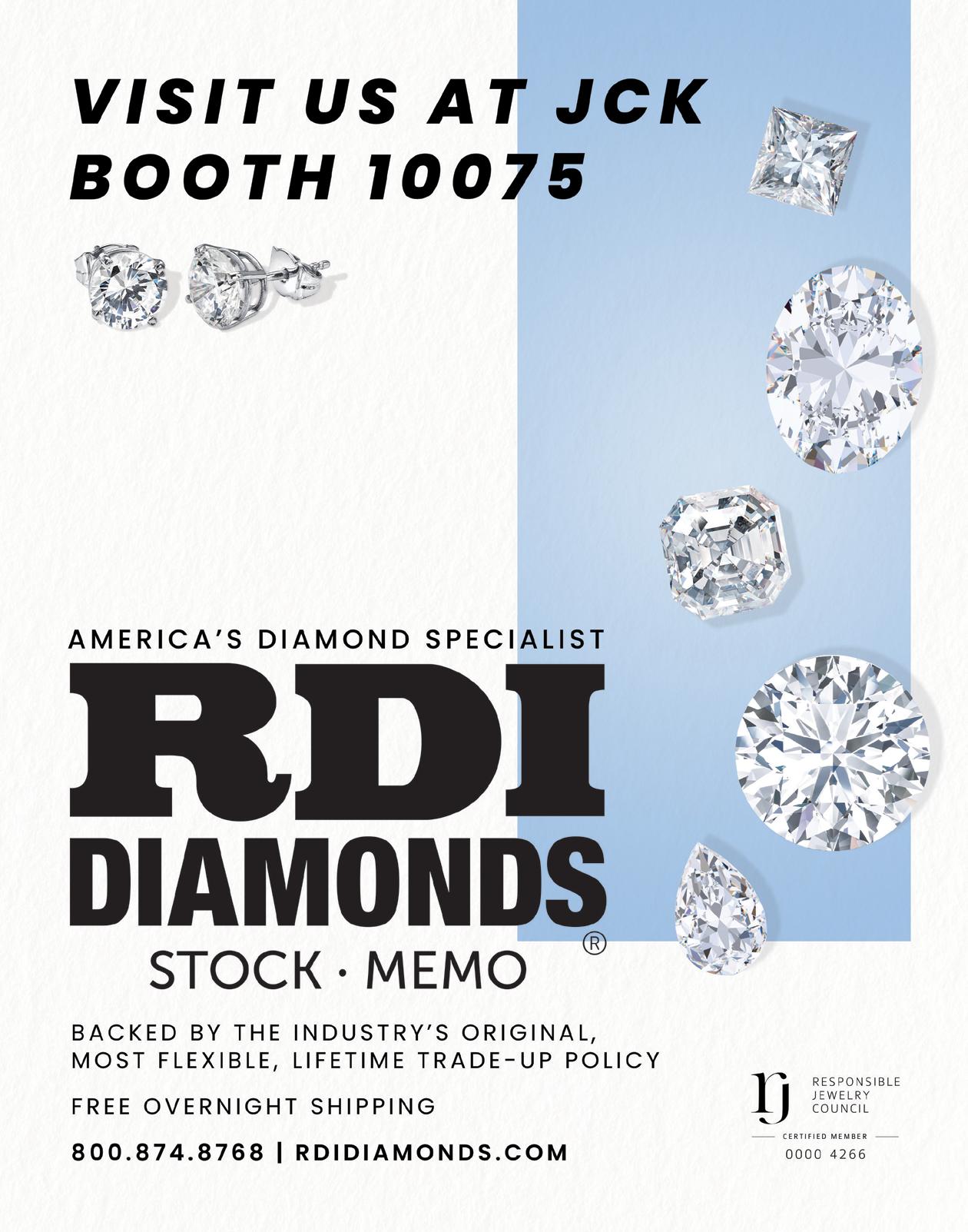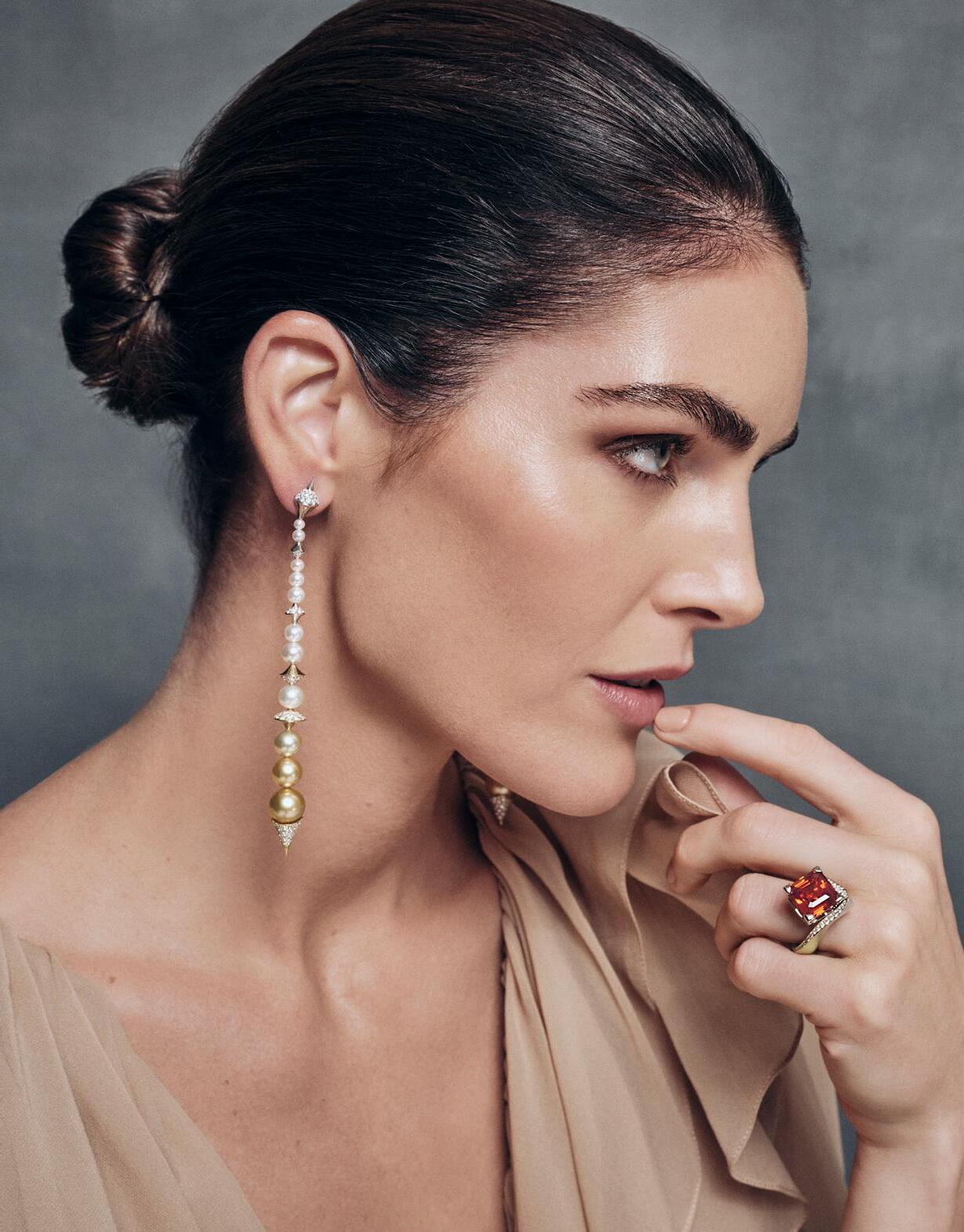

FORWARD LOOKS
From gems to men’s: The most game-changing jewelry trends right now

VOL. 47 NO. 3 MAY-JUNE 2024
IN-DEPTH
10 Analysis: Rio Tinto’s Art Series
12 Show report: GemGenève
14 Education: Jewelry courses
SHOW PREVIEWS
17 JCK and Luxury
20 Couture
22 Antique Jewelry & Watch Show
COVER STORY
24 Three game-changing trends that are having a moment: Colored-gem bridal rings, jewelry lines for men, and mixed-metal designs
RETAIL
34 Featured store: Marrow Fine
36 Design collaborations
STYLE
40 Interview with the author of Jewelry’s Shining Stars
42 Trending: The Mob Wife aesthetic
44 Designer: Adam Neeley
COLORED GEMSTONES
46 Inside Paris’s Musée de Minéralogie
48 What the diamond world can learn from synthetic gems
50 Buying from AGTA members
AUCTIONS
52 The Geneva sales
54 Behind the gavel: Annabelle Cukierman
ESTATE JEWELRY
56 Book review: Antique French Jewelry 1800-1950
60 The art of archiving
WATCHES
65 Turning dials into miniature paintings
66 Timepiece trends from Watches and Wonders
70 Embracing sustainability
74 Directory
75 Calendar
76 Career Q&A: Randi Molofsky
WHAT’S THE LEVEL OF OUR COMMITMENT? WHAT’S



































































































EDITOR IN CHIEF: SONIA ESTHER SOLTANI
SENIOR ANALYST: JOSHUA FREEDMAN
NEWS EDITOR: LEAH MEIROVICH
SENIOR COPY EDITOR: RACHEL BEITSCH-FELDMAN
COPY EDITOR: NECHAMA VEEDER
ART DIRECTOR: TARDEO AJODHA
SENIOR DESIGNER: DAVID POLAK
DESIGNER: NICOLE BEDNARZ
DATA ANALYST: OREN YANNAI
VICE PRESIDENT OF OPERATIONS: DAVID EHRLICH
PROJECT MANAGER: ANNA SIMAKOVA
SALES OPERATIONS MANAGER: ZOIA KOLTON
SALES AND OPERATIONS COORDINATOR: YANA SHLYAKMAN
PODCAST AND VIDEO PRODUCER: VANINA PIKHOLC
RAPAPORT DIAMOND REPORT Issue No. 3 Vol. 47 May-June 2024 (ISSN 0746-9829) is published bimonthly for $210 US, $310 International per year by Rapaport USA Inc., 133 E Warm Springs Rd., Suite 100, Las Vegas, NV 89119. Periodical postage paid at Las Vegas, NV, and additional mailing offices. POSTMASTER: Send address changes to Rapaport USA Inc., 133 E Warm Springs Rd., Suite 100, Las Vegas, NV 89119.
PUBLISHER: MARTIN RAPAPORT
ASSOCIATE PUBLISHER: LEA SCHIFF
ADVERTISING SALES MANAGER : CHAMUTAL LEVIN CHAMUTAL.LEVIN@RAPAPORT.COM
BUSINESS DEVELOPMENT MANAGER, INDIA: TANYA JHA
TEL: 91.22.6628.6592
TANYA.JHA@RAPAPORT.COM
TO CONTACT EDITORIAL: SONIA ESTHER SOLTANI SONIA.SOLTANI@RAPAPORT.COM

Model Hilary Rhoda wears Adam Neeley Echo ear pendants, which feature white akoya and South Sea pearls and diamonds in 14-karat white gold and 14-, 18-, and 22-karat yellow gold for an ombré effect. She also wears the Oriana ring with a 14.19-carat orange sapphire and diamonds in Neeley’s SpectraGold. Photography by Beau Grealy.

RAPAPORT
CONTENT
BY RAPAPORT USA INC.
1212 AVENUE OF AMERICAS, SUITE 801 NEW YORK, NY 10036, USA TEL: 212.354.9100 NY@RAPAPORT.COM
133 EAST WARM SPRINGS ROAD, SUITE 100 LAS VEGAS, NEVADA 89119, USA TEL: 702.893.9400 INFO@RAPAPORT.COM
RAPAPORT INTERNATIONAL
RAPAPORT BELGIUM HOVENIERSSTRAAT 53, BOX 13 B-2018 ANTWERP, BELGIUM TEL: 32.3.232.3300 BELGIUM@RAPAPORT.COM
RAPAPORT ISRAEL
TUVAL ST. 21, SUITE 1362 RAMAT GAN 52521, ISRAEL TEL: 972.3.613.3330 ISRAEL@RAPAPORT.COM
RAPAPORT INDIA
101, THE CAPITAL, PLOT NO C-70, BKC, BANDRA EAST MUMBAI 400 051, INDIA TEL: 91.22.6628.6500 INDIA@RAPAPORT.COM
RAPAPORT INDIA – SURAT 501-504 C WING, DIAMOND WORLD BUILDING, MINI BAZAAR, MANGADH CHOWK, VARACHHA ROAD
SURAT 395 006, INDIA TEL: 91.261.672.3300 INDIA@RAPAPORT.COM
RAPAPORT HONG KONG
UNIT 404-405, PROSPEROUS BUILDING 48-52 DES VOEUX ROAD CENTRAL, HONG KONG, CHINA TEL: 852.2805.2620 HK@RAPAPORT.COM
RAPAPORT DUBAI DUBAI DIAMOND EXCHANGE LEVEL 2, OFFICE D06 ALMAS TOWER, JUMEIRAH LAKE TOWERS PO BOX 340600, DUBAI, UAE DUBAI@RAPAPORT.COM

Contributors
Spotlighting some of the talented writers in this edition of Rapaport Magazine

CATHLEEN MCCARTHY
Men’s fine jewelry is growing faster than women’s, thanks in part to trendsetting male celebs. In this issue, I get the scoop on Brilliant Earth’s experiments with gender-neutral looks, and David Yurman’s first foray into men’s high jewelry with brand ambassador Michael B. Jordan. Stephen Webster dishes on his collaboration with Machine Gun Kelly and a new in-store shop in Nashville, complete with a bar and live music.
RUTH PELTASON
As a longtime editor of art and illustrated books, as well as an author and lecturer, I’ve always believed that education is the mark of a cultured society. Now that I am also teaching jewelry history, I’m keenly aware of the need to educate young people, especially those in the industry. The classroom is the best way to ensure that jewelry receives respect as an art form and as a means to a promising career.
BETH BERNSTEIN

Do you keep an archive? Many jewelry companies do, and the benefits range from inspiration for new collections, to aiding with authentication and helping others tell the brand’s story. In this issue of Rapaport Magazine, I speak to jewelry archivists about their work, and ask their advice on how best to start an archive.


I am passionate about the articles for this issue. In previewing the Las Vegas Antique Jewelry & Watch Show, I discuss how the demand for rare, authentic pieces from multiple periods continues to fuel this segment of the market. In contemporary jewelry, retail and designer collabs are the new direction many stores are taking for a more personalized in-store experience, while colored gemstones offer a meaningful approach to bridal rings. All of this points to consumers’ ongoing desire for more individualistic jewelry.
Also in this issue:
Richa Goyal Sikri, Jennifer Heebner, Joshua Hendren, Joyce Kauf and Phyllis Schiller RACHAEL TAYLOREditor’s letter
 S onia Esther Soltani EDITOR IN CHIEF I SONIA.SOLTANI@RAPAPORT.COM
S onia Esther Soltani EDITOR IN CHIEF I SONIA.SOLTANI@RAPAPORT.COM
Some of you reading this are Las Vegas veterans. For others, it’s your first time, and you’ve been asking friends and colleagues for recommendations on how to make the most of this hectic, packed event — especially if you intend to hop from JCK to Couture and the antique shows. There is anticipation, excitement and maybe some apprehension in the air. This year, the economic and political environment in which the gatherings take place has made for a heavier mood. But this is also a time to catch up with your network and expand your ideas and business opportunities. It’s the perfect opportunity to celebrate great design and seductive jewels that will get your clients enthused later this year.
For this issue’s cover story, we selected three trends that are going strong with US jewelry wearers: colored stones for bridal, men blinging it up, and freely mixed metals. None of these is a 2024 invention, but in the merry-go-round of fashion, they are all gaining momentum and making a lasting impact on purchasing decisions. We look forward to discovering more epic jewelry in Vegas and wish everyone attending a successful and enjoyable time.
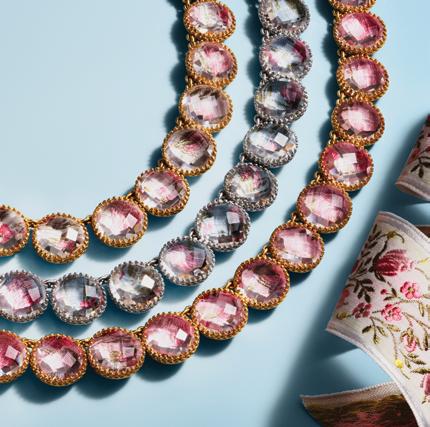

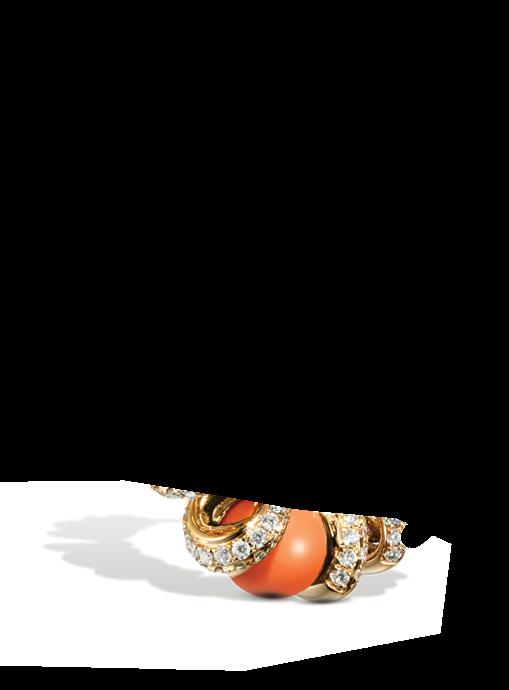
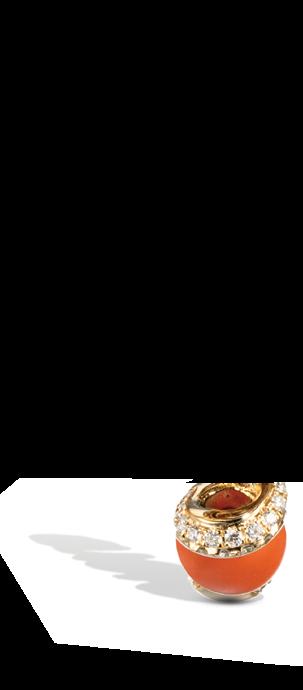
EDITOR’S PICKS

ABOVE: Melinda Zeman’s sophisticated, tongue-in-cheek Boochier brand offers vibrant designs to jewelry lovers. One of my favorite pieces from the Hong Kong-based jeweler is these Gumball Slinkee earrings with coral, pink opal and diamonds, which are the ideal day-to-night jewels.
LEFT: Emily Satloff’s love of Georgian jewelry is the main source of inspiration behind her elegant and romantic Larkspur & Hawk creations. For her Ribbon collection, she used vintage ribbons she had been collecting over the years to line each setting beneath faceted quartz stones. These three delicate rivière necklaces come in yellow gold-washed sterling silver or white rhodium-washed sterling silver.








 Martin Rapaport PUBLISHER MARTIN@RAPAPORT.COM
Martin Rapaport PUBLISHER MARTIN@RAPAPORT.COM
Note from the Publisher
A WORLD OF CHANGE
The world around us is undergoing a series of perfect storms. Big changes are taking place, and they are going to influence how we can make a living. The situation is serious. Competition from synthetics, Russian sanctions, Gen Z demand, falling prices, China slowdown, India booming, Botswana beneficiation, blockchains, social responsibility, and more are forcing us to change the way we do business, with whom we do business, and even why we do business.
The best way forward is to focus on our customers and their needs rather than our products and our needs. New generations of consumers must learn about the joy of giving and receiving jewelry. Older consumers need help recycling their expensive jewelry. We must carefully position ourselves and consider: Who are the new consumers? Where are they? What are they thinking? What do they want? How do we reach them? How do we help add value to the people we buy from and sell to?
By concentrating on people rather than products we have the flexibility to create new products that customers desire. Modifying products to highlight their benefit to society — if that is what Gen Z consumers value. Recognizing the fact that millennials are older and want to have families with children and a much greater sense of security. What should we change to better serve these vital customers? What do we want to give our customers? What do they need, not just what do they want.
At Rapaport we are implementing important changes. We are relaunching the Rapaport Magazine as a jewelry-centric
magazine. Price information and data presentations have been moved to a new Rapaport Diamond Report. We will also be greatly expanding our digital environment with new Rapaport.com sections, analysis, webinars, videos, podcasts, and surveys.
RapNet is introducing a new BuyNow service enabling direct Rapaport quality control, shipping, and payment services for approved RapNet buyers and suppliers. We are also introducing a new Rapaport Source Certification program that will certify the rough source of polished diamonds and provide a “Green Star” listing for socially responsible diamonds offered for sale on RapNet.
Our “State of the Diamond Industry” breakfast presentation at the JCK show will focus on significant changes taking place in the diamond and jewelry industry. It will help companies develop strategic plans that will protect and grow their business.
Our special guests will include Mmetla Masire, managing director of the Botswana government’s Okavango Diamond Company, which is responsible for selling 25% of Debswana’s annual $4 billion rough diamond production. Also participating on the stage is Maksud Agadjani, 47th Street’s superpowerful rap jeweler with 1.6 billion views on social media.
I take this opportunity to invite you to the Rapaport Breakfast at the Las Vegas JCK Show, June 2, at 8 a.m. in San Polo Ballroom, Level 3 at the Venetian. The presentation will also be available online. Registration is now available at Rapaport.com/JCK24-Breakfast
RIO TINTO AND THE VALUE OF PRESENTATION
With its recent tender of exceptional pink, red and yellow diamonds, the miner helped boost demand by casting them as works of art. By Rachael
Taylor
At the close of last summer, invites to a very exclusive party started to land in the inboxes of the world’s top diamond dealers, jewelers and private collectors. The sender was Rio Tinto, and the event was the launch of The Art Series.
While the title might suggest that the miner was breaking into a new industry, it was in fact a new concept for selling fancy-colored diamonds. The invite-only tender, also known as the Beyond Rare Tender, was a collection of 87 rare polished diamonds, including pink and red specimens from the Argyle mine in Australia, and yellow ones from Diavik in Canada. Besides 11 matched pairs and 30 single stones, there were seven grouped sets called “Masterpieces,” which came with accompanying bespoke artwork.
Those who made it onto the invite list had a month to view the stones’ credentials through a dedicated online portal before attending The Art Series’ in-person events in Australia,
Switzerland and Belgium in midOctober. The miner then gave bidders another month to mull over what they had seen, with sealed bids closing on November 20.
Rio Tinto Minerals chief executive Sinead Kaufman has described the Beyond Rare Tender as “a new chapter for Rio Tinto’s diamond business, and
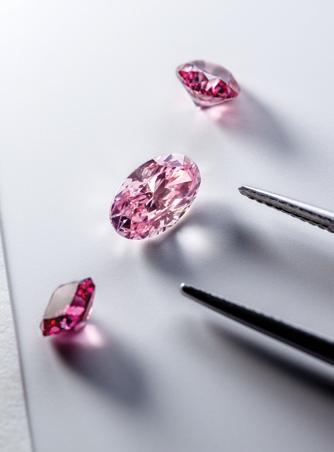
a testimony to the ongoing demand for highly collectible natural diamonds.”
The demand is certainly there. While the diamond market has softened in general, prices for pinks have remained protected, according to dealers. And prices for rarer red diamonds have increased 25% since 2020, reports dealer Leibish & Co.
Still, The Art Series is not just about catering to preexisting demand; it’s also about stirring it up and adding value. By presenting colored diamonds as art in this way, it is encouraging us to view such stones as we might a piece of serious art: as an investment-grade collectors’ item that we also enjoy in the moment for its beauty.
A matter of strategy
The inclusion of pink Argyle diamonds in the sale caused a split reaction among dealers and jewelers, as it went against the narrative that had been driving up prices since the mine’s closure in 2020.
“In the industry, we said with full confidence to our clients that when the mine is shut, no more pinks are going to come from that mine, and the demand skyrocketed,” says Harsh Maheshwari, executive director of Kunming International. And that was true, he points out; “there were no more pink diamonds that came out of the mine. These were Rio Tinto’s remaining pink diamonds that were kept in the vault to find a better way to present them and continue the legacy.”
Maheshwari believes Rio Tinto has struck upon a brilliant solution with The Art Series. “The tenders, the marketing…everything was beautifully done, and there was some hype around Argyles again because of the tender,” he says. Kunming was one of the event’s successful bidders, walking away with 14 lots, including two red diamonds.
Placing yellow diamonds from Diavik alongside the rare Argyle reds and pinks was a strategic move by Rio Tinto

to elevate the status of the Canadian stones, believes Leibish & Co. president Leibish Polnauer, who successfully won stones in The Art Series as well.
“Rio Tinto is a master of brand management and value creation,” he says. “It is trying to capitalize on the Argyle brand value and extend it beyond the pink diamonds — an interesting move.”
Canada in focus
Rio Tinto is not the only company trying to amplify Canadian yellow diamonds. Just two days after the miner made its Beyond Rare Tender public news, Tiffany & Co. announced the acquisition of a 71-carat, fancy-vividyellow rough stone from Burgundy Diamond Mines’ Ekati deposit. Tiffany cut the rough into two polished diamonds of 15 and 20 carats.
“[The company] is trying to capitalize on the Argyle brand value and extend it... an interesting move”
The move reflects “Tiffany’s heritage of acquiring the most coveted gems on earth,” according to Victoria Wirth Reynolds, the brand’s chief gemologist. Tiffany also linked the stones to its earlier 2023 acquisition of “similarly rare” Argyle pink diamonds.
“The inclusion in the inaugural Beyond Rare Tender of two fancyintense-yellow diamonds from Rio Tinto’s Diavik diamond mine is a beautiful counterpoint to the pink and red Argyle diamonds,” comments
Patrick Coppens, general manager of sales and marketing for Rio Tinto Diamonds. “Yellow diamonds make up less than 1% of Diavik’s production, a rarity in a diamond mine otherwise known for its highly coveted whitediamond production.”
Coppens believes the market is ripe for such sales due to an “unwavering global demand for truly scarce gems,” and the plan is to hold more sales in the style of The Art Series.
Maheshwari, for one, will be there if there is, wringing his hands with nervous excitement as he awaits the fate of his sealed bids.
“Rio Tinto has built a beautiful ecosystem that has helped create value for something that would have been part of the rejection parcels for diamantaires 30 years ago,” says the dealer. Plus, he adds, the events “are a lot of fun.”
GEMGENÈVE IN UNCERTAIN TIMES

Inflation, falling diamond prices, and geopolitical issues compounded the Swiss show’s existing challenges.
By Joshua Freedman
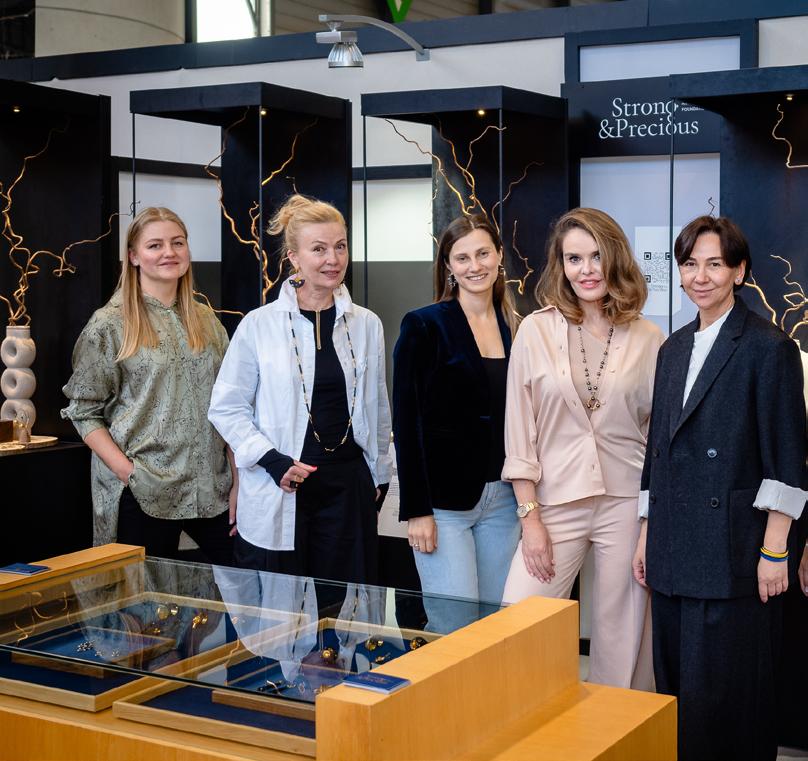

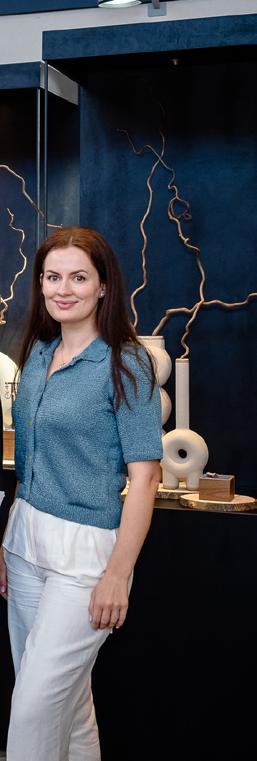
The GemGenève show, which took place this year from May 9 to 12 in Geneva, Switzerland, is an important indicator of how the high-end market is doing. The fair attracts sellers of large, top-quality diamonds and gemstones, as well as leading luxury brands that come to buy.
This year’s show occurred amid an uncertain environment for the trade. High inflation and interest rates in key markets such as the US have impacted consumer spending, and the Chinese luxury market is weak.
Prices of high-clarity diamonds have been falling this year, as Rapaport reported in its May press release on the RapNet Diamond Index (RAPI™). Lower-clarity stones, such as SI1s and SI2s, have improved for a number of reasons, including the fact that these categories suffered heavily last year.
In addition, some industry participants say the high-end brands did a lot of buying last year and now don’t need much new merchandise, even if their sales are good. However, dealers report that exceptional large stones have been performing better than their bread-and-butter goods, as the economic challenges have had less of an effect on the wealthy.
So how did all of this impact GemGenève?
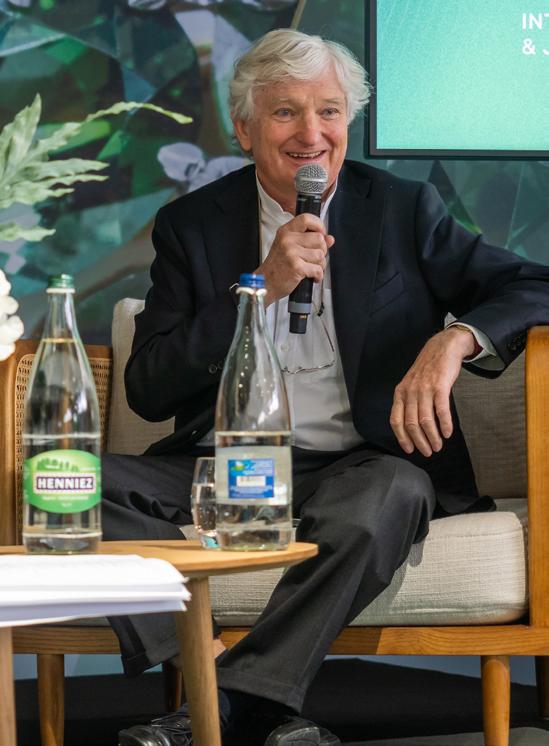
Exhibitors who attended the show said traffic and sales were weak overall due to the state of the market, with luxury brands buying little. But as the vendors also noted, GemGenève is not a big show for purchases, unlike JCK Las Vegas or the Hong Kong fairs.
There was still demand for spectacular large diamonds, which are in short supply because of a drop in manufacturing and the relatively high price of rough.
Another factor was the timing of the show. The first two days were busy, but the traffic tailed off due to the Ascension Day holiday in France and some other European countries. Also, some of the Israeli participants wanted to return to Israel for Memorial Day, which started on Sunday night.
GemGenève has not had the easiest run. The November 2023 show also saw a decline in visitors due to the geopolitical situation, including the Israel-Hamas war, which led to fewer Israelis attending. In the wake of Covid-19 and the ensuing shift to digital commerce, the concept of the trade show took a hit from which it is still recovering.
Later this month, with uncertainty still hanging over the trade, the industry will gather in Las Vegas for the JCK fair. Let’s see if trading picks up in time for that event.
This is an edited script from the May 16 edition of the Rapaport Market Comment video. To watch all videos, visit rapaport.com/videos.

KNOWLEDGE IS POWER
Learning jewelry history can open up jobs and opportunities as well as minds. Here are some of the options out there. By Ruth Peltason
Say the word “school,” and most industry professionals freeze up. However, a foundational knowledge of jewelry history is the best passport to excelling in the field. Auction house specialists, museum curators, retailers, jewelry dealers and designers all benefit from learning at accredited institutions like Sotheby’s Institute of Art (SIA) or through a wide selection of online courses.
In the US, places such as Pratt, the New School, Rhode Island School of Design (RISD), Bard Graduate Center, and the Savannah College of Art and Design (SCAD) previously offered courses on jewelry history, but now focus on teaching technique instead. To fill that gap, members-only clubs and venues abound for the serious-minded and layperson alike. Today, these organizations include the American Society of Jewelry Historians (ASJH), the Art Jewelry Forum (AJF), the Association for the Study of Jewelry and Related Arts (ASJRA), New York City Jewelry Week (NYCJW) and Gem X. Wherever one chooses to learn, a familiarity with jewelry history is what we might call “required reading.”
L’École: A wide range of small classes
“Sharing jewelry culture with the public at large” is how Lise Macdonald, president of L’École School of Jewelry Arts, describes the mission of this elegant, nomadic institution. Van Cleef & Arpels developed and funds L’École, which began in Paris in 2012 and today
has permanent campuses in Hong Kong, Shanghai and Dubai. Discussions of opening an American campus are currently in the works.
L’École centers three pillars of learning in its quest to lift the curtain on the fine-jewelry world: savoir faire, gemstones and history. For the enthusiastic generalist, and for those with extra time in their day, the school offers a medley of classes, workshops, lectures and free exhibitions. The courses — which L’École keeps small at 12 participants and two instructors on average — range from history and gemstone studies to practical applications such as making gouache renderings and sampling lapidary skills. There are even jewelry workshops for young children and teens.
Sotheby’s Institute of Art: ‘Object-based lessons’
For the young academic seeking an accredited master’s degree, SIA in New York has been among the finest in the art education business since 1969. SIA’s move into offering jewelry studies as a discipline is the work of its current program director, Ann-Marie Richard. Having observed a void in jewelry education, Richard developed the “History of Gems and Jewelry” course in 2017.
The institute’s “focus on a twopronged pedagogy seemed perfectly suited to [engaging] in the teaching of jewelry, contextualizing the history of gems and jewelry in concert with object-
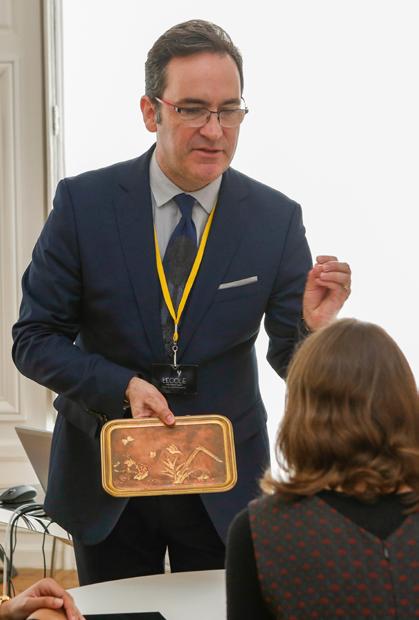
based lessons,” she says. Those lessons occur through carefully designed classroom lectures and bespoke tours of museum collections and jewelry auction previews, as well as visits to leading jewelry companies and respected dealers and boutiques. Guest speakers from all sectors of the industry offer invaluable first-person experience and networking opportunities. Does this lead to careers in the jewelry industry? The answer is an emphatic “yes.” There is the obvious segue to the auction world, as well as becoming an archivist, researcher


in the auction house,” says Weintraub. In what she calls more “experiential learning,” there are casual field trips for enthusiasts and clients of the house to meet dealers and jewelers.
But the hidden gem at Christie’s Education is jewelry historian Vanessa Cron. For years, her deep-dive instruction and passion have attracted enthusiasts as well as colleagues. Her in-person courses for Christie’s in New York, London and Hong Kong became known for setting a standard of excellence. Although she no longer teaches in person, her prerecorded online courses are superb and are still available on the company website.

or dealer, or working at a legacy jewelry company.
Christie’s Education: The value of a good teacher
Christie’s Education in New York offers courses “geared toward collectors, enthusiasts and professionals,” according to program director Sara Weintraub. Classroom lectures, typically attended by jewelry collectors and Christie’s clients, tend to be allied with the auction house’s Magnificent Jewels sales in an effort to “lend transparency and academic integrity to the property

Career-complementing online courses
The most dramatic change in teaching the history of jewelry has been the continued development of online instruction. What began out of necessity during the pandemic has morphed into a steady outlet for learning. Moreover, the flexibility of online courses makes it easier for industry professionals and enthusiasts to accommodate their jobs.
The better-known sources for online learning include SIA London, Christie’s, the Victoria and Albert Museum’s V&A Academy Online, and the “Jewellery Foundation” course by jewelry authority and author Joanna Hardy. Since the pandemic, Lisbon-based gem and jewelry expert Rui Galopim de Carvalho has developed his own online courses in everything from gemstones to history to sales training, with industry professionals from the US accounting for about 20% to 25% of his students.
All of this goes to show that the learning curve keeps on curving — and that sometimes, in order to step forward, you need to look back.
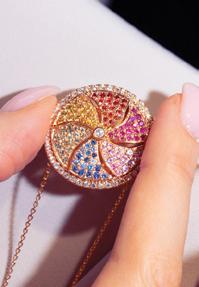




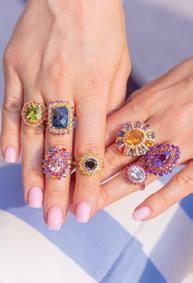
The jewelry trade's most important global gathering
JCK GATHERS THE COMMUNITY WE’VE CULTIVATED AND THE INDUSTRY WE’RE A PART OF AND LOVE. FROM THE BRANDS YOU KNOW AND LOVE TO NEW ONES YOU WILL DISCOVER, FROM THE NETWORKING AND LEARNING, INNOVATION AND SERENDIPITOUS MOMENTS... ARE YOU A PART OF THE MOST-LOVED SHOW?
Friday, May 31 – Monday, June 3, 2024
OPENING MAY 30
NEW: HONG KONG PAVILION NEW: THE SUSTAINABILITY SUMMIT AT JCK GEMS & JCK TALKS
WANT TO TAKE IT TO THE NEXT LEVEL? LEARN MORE ABOUT HOW AN UPGRADED BADGE UNLOCKS A JCK EXPERIENCE LIKE NO OTHER. THE VENETIAN


SIN CITY DISCOVERIES
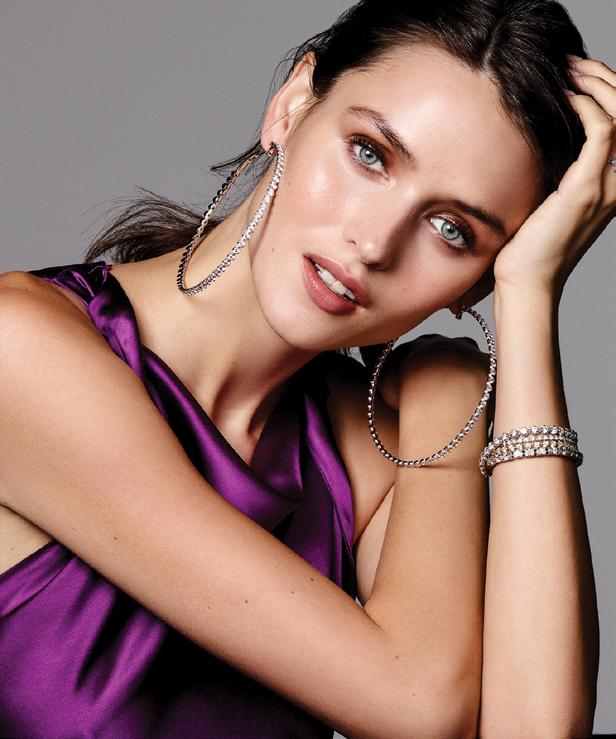
What can you expect to see at JCK Las Vegas and Luxury? Exhibitors share their plans and predictions for the Nevada jewelry shows. By Jennifer HeebnerEDDIE LEVIAN CEO, LE VIAN
Le Vian is unveiling a treasure trove of collections and new designs in its appointment-only high-jewelry room at JCK. For our annual Red Carpet Revue, jewelry influencer Julia Hackman Chafé of @JewelswithJules will engage with luminaries, while our event’s emcee, the world-renowned master mentalist Lior Suchard, will weave Le Vian’s jewelry trends into his mesmerizing acts. The denouement will be an electrifying musical performance by Mark McGrath of Sugar Ray. Despite the tumultuous
descent of synthetic-diamond prices, [which] has prompted a wave of caution among retailers, Le Vian predicts a surge in sales, increased brand positioning and a swell in show attendance. Plus, for the first time, high-quality platinum jewelry has not only surpassed the purity and endurance of gold, but triumphed in affordability as well.
ERIC YEN MANAGER, YEN’S JEWELRY & ACCESSORIESSales in 2024 began with cautious optimism, but we believe there is untapped potential in pearls, with designers yet to fully explore this sector. There is an upward trend in demand for smaller-size pearls, appealing to a younger demographic. In Las Vegas, we’ll unveil super round and high-quality baby Chinese Edison freshwater pearls, also known as bead-nucleated pearls, ranging from 2 to 6 millimeters. These meet the demand for hard-to-find akoya pearls. And while Yen’s is renowned for intense natural-color freshwater pearls with
deep purples and metallic overtones, we also boast a large selection of South Sea ombré pearls. Additionally, our curated collection of saltwater akoya strands includes rare 10- to 11-millimeter and 11to 12-millimeter varieties, and we stocked up on small 8- to 10-millimeter Tahitian strands graded “ocean blue” by the Pearl Science Laboratory.
MELANIE GOLDFINER GOLDBERG DIRECTOR OF MARKETING AND BUSINESS DEVELOPMENT, RAHAMINOV DIAMONDSWhile sales are stable, we remain resilient and adaptive, fulfilling a growing appreciation for quality over quantity. Expectations are tempered by market conditions, but we’re optimistic about fostering positive sentiment and forging fruitful partnerships at the show. Our focus on quiet luxury and understated elegance resonates with the sentiment that less is indeed more. We anticipate that JCK Luxury and JCK Las Vegas will provide a welcome opportunity for attendees to indulge in the finer things, offering a sense of comfort amid turbulent times. We’re thrilled to expand our Movál collection with new necklaces, timeless pieces featuring fresh gemstones, and designs that blend innovation with classic elegance. We also anticipate that retailers will gravitate toward classic jewelry pieces, prioritizing timeless elegance over fleeting trends.
GARY LEVINE DIRECTOR OF BUSINESS DEVELOPMENT, SYLVIEDespite geopolitical tensions and economic shifts, Sylvie Collection has seen its strongest growth over the last three years, with the first few months of 2024 being our strongest-ever first quarter. Our retailers are interested in the evolving preferences and interests of younger consumers, and the impact of digital marketing on retail traffic. Regarding trends, we see a strong lean toward minimalism in bridal and

“We believe there is untapped potential in pearls, with designers yet to fully explore this sector”
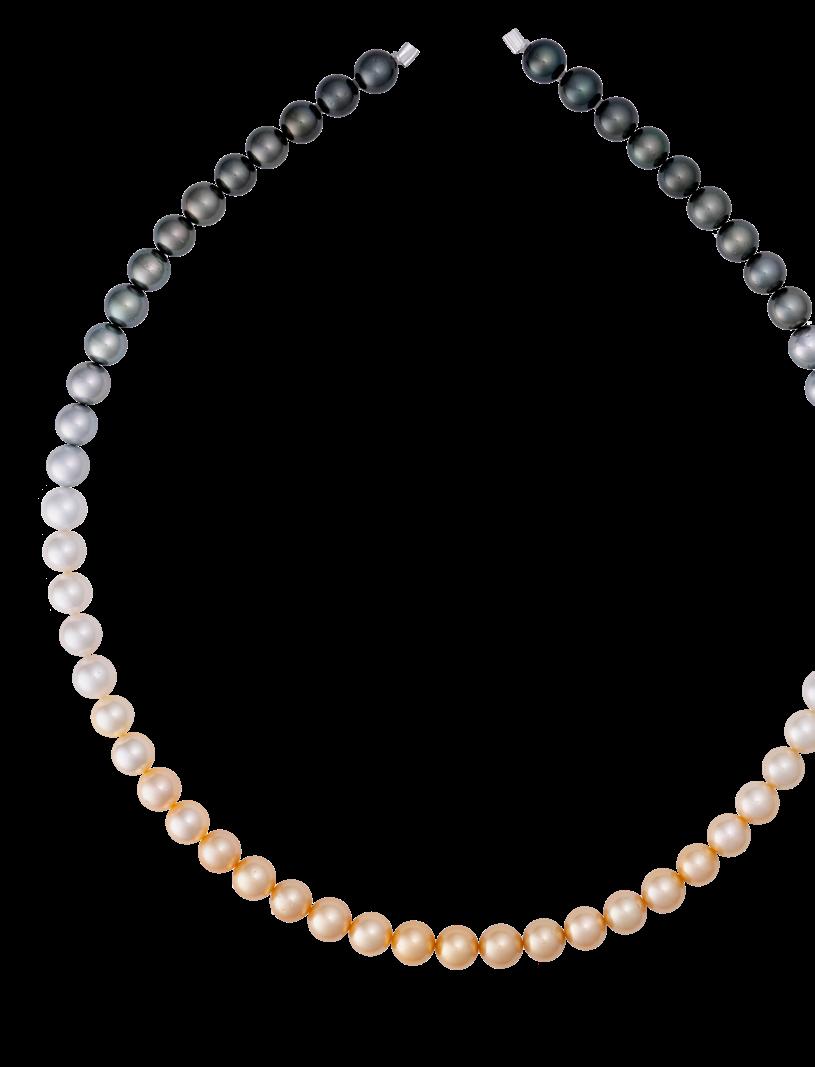
evident in our new line of men’s wedding bands. More new collections include Shell Iconelle and Tulira, the former featuring [founder and designer Sylvie Levine’s] signature shell motif, and the latter a collection of engagement rings and wedding bands inspired by...the Belgian springtime of her childhood.
AMISH R. SHAH FOUNDER, ALTR AND J’EVARWe already have over 25 patents in diamond cuts but will present new ones tailored to the lab-grown diamond category. We’ll also unveil J’Evar, our fine-jewelry consumer brand featuring
type IIa lab-grown diamonds [with an SCS 007 certified sustainability rating. The diamonds are] created with solar energy, [have] a net-zero carbon footprint and guaranteed traceability, [and are] set in recycled gold. One of our new jewelry collections includes symmetrically cut diamond letter pendant necklaces in 18-karat gold, while another has step-cut diamonds boasting internal reflections and refractions to capture more oblique light, making the diamonds more visible from greater distances. Finally, [we have] Lotus Petals, a patent-pending setting that enfolds each diamond in an open lotus-petal motif...representing purity and holding each diamond like a sacred offering.
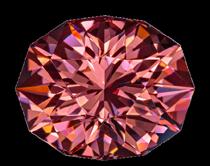


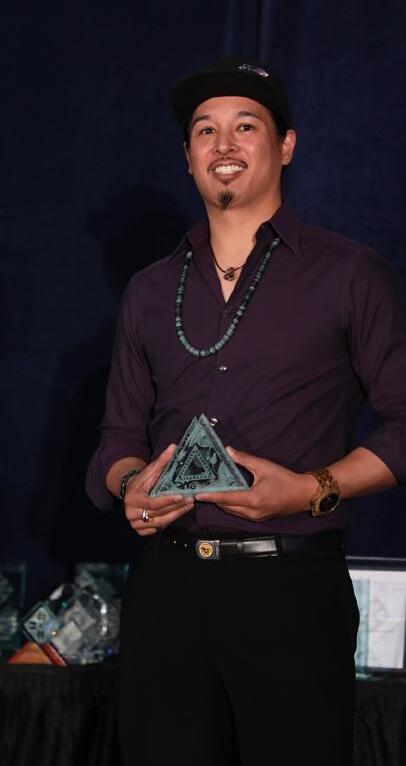

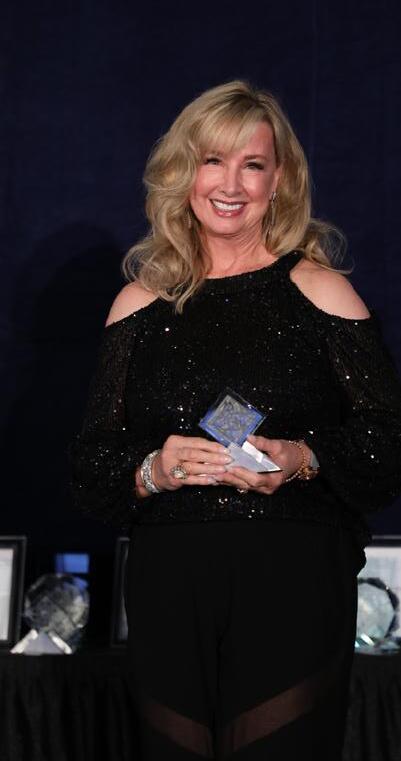




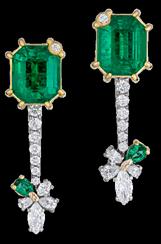
Will You Be The Next Winner?
Enter the 2024 AGTA Spectrum & Cutting Edge Awards to set the industry standard for beauty, innovation, and experience sales growth like never before.
Early Bird Deadline: 9.6.24
Final Deadline: 9.20.24

1st entry $265, all subsequent entries $205 each. 1st Entry $295, all subsequent entries $225 each.

 Bryan Lichtenstein, 3090 Gems, LLC
Desmond Chan, Gem Arts International
Dallas Prince, Dallas Prince Design
Marcia Budet, Marcia Budet
Bryan Lichtenstein, 3090 Gems, LLC
Desmond Chan, Gem Arts International
Dallas Prince, Dallas Prince Design
Marcia Budet, Marcia Budet
BURSTS OF COLOR
A selection of vibrant, charismatic pieces starring in the Couture show.
By Sonia Esther Soltani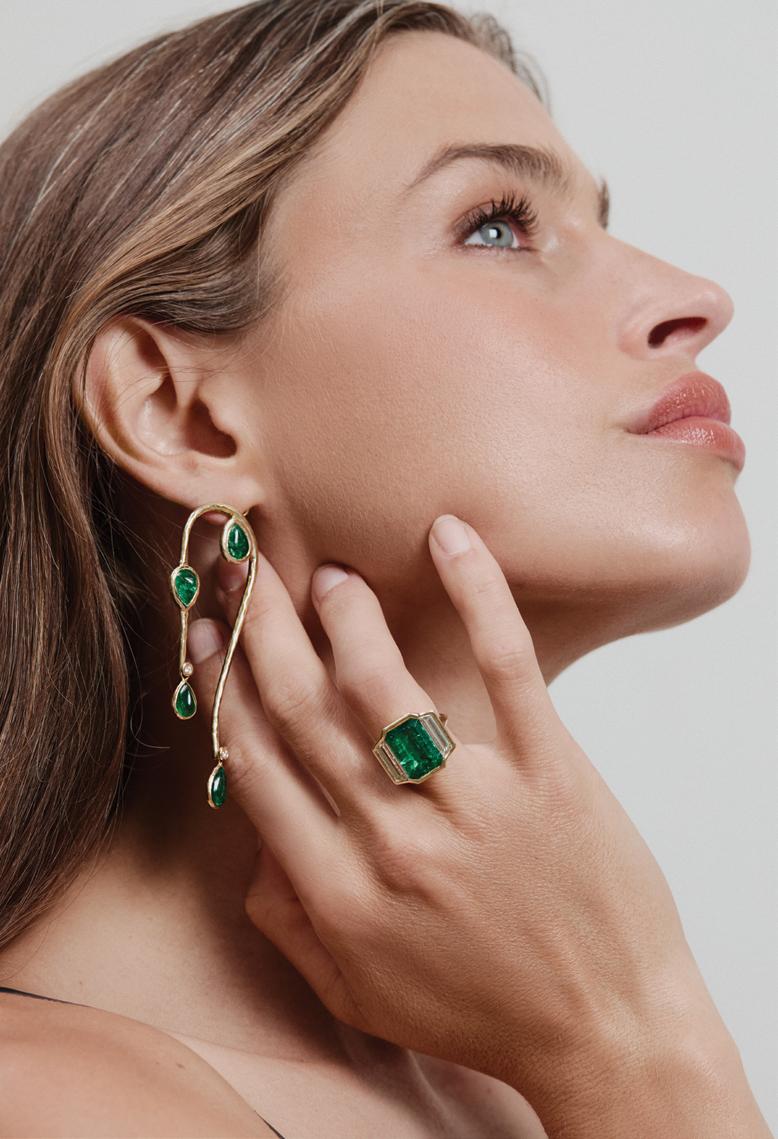



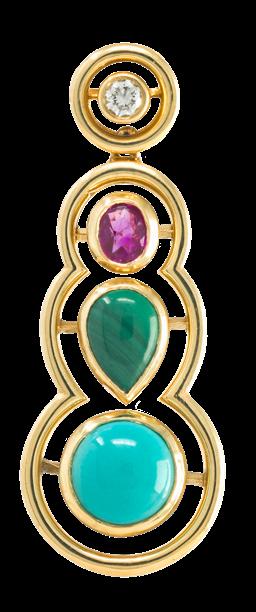
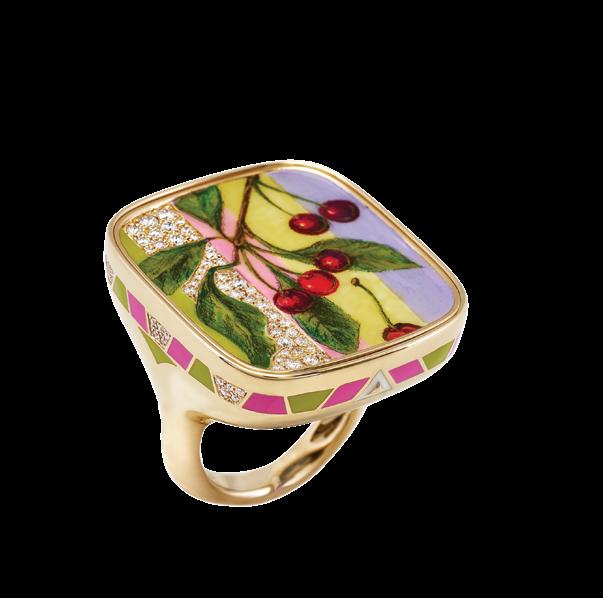

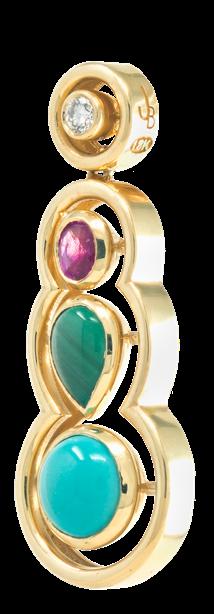
1. Octavia Elizabeth Eucalyptus emerald earrings and engagement ring on model; 2. Assael earrings in Sardinian coral, lagoon tourmaline, and Sonoran Sunrise jasper; 3. Sanaz Doost turquoise Peacock ring; 4. Lord Jewelry pendant with opal, diamonds, emeralds and enamel; 5. Jenna Blake gem-set Morse Code earrings; 6. Francesca Villa Change Your Stripes ring; 7. Artëmer rainbow sapphire ring; 8. Pamela Zamore Eos collar necklace; 9. Orly Marcel Bliss earrings.
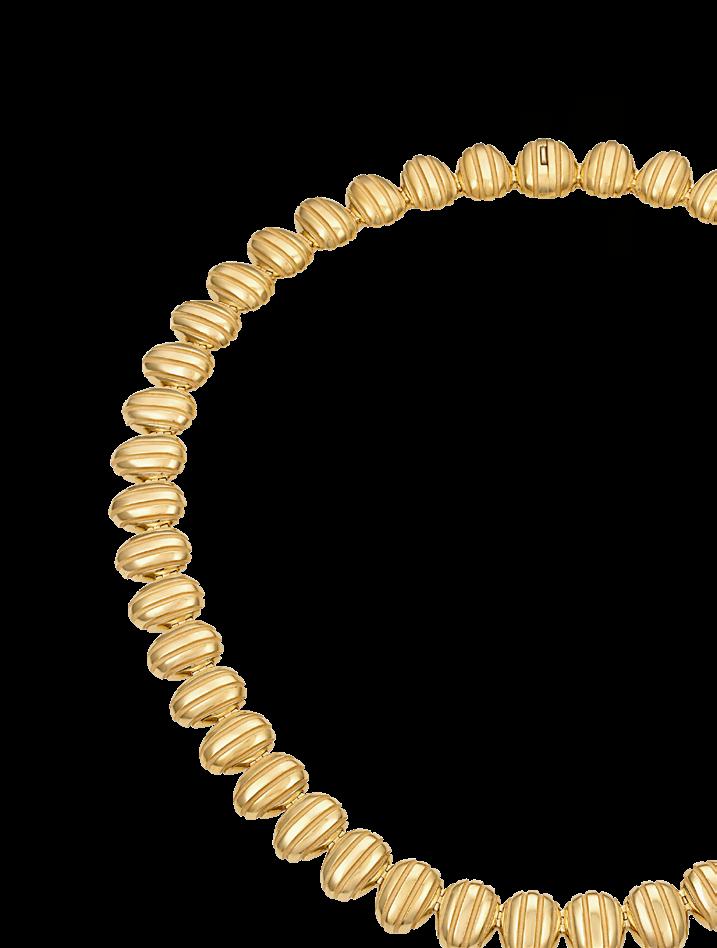
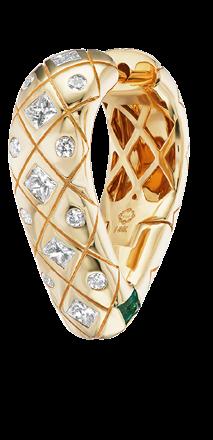

LOOKING FORWARD TO THE PAST
The
most anticipated
trends at the Las Vegas Antique Jewelry & Watch Show.
By Beth BernsteinRare, authentic, original and museumquality are some of the terms that five expert antique and vintage dealers are using to describe their offerings at this year’s Las Vegas Antique Jewelry & Watch Show. While trends in this category traditionally follow cyclical patterns, specific periods aren’t as apparent this year. Still, the five dealers are reporting certain recurring themes and they all agree on what is driving buyers’ choices.
“Antique and vintage jewels are consistently influenced by celebrities, fashion and marketing,” says Kerri Orlando, jewelry specialist at Wilson’s Estate Jewelry in Philadelphia, Pennsylvania.
“These days, social media reigns supreme. Younger generations are actively seeking more unique, sustainable, meaningful pieces, and they control that narrative.”
Dana Kiyomura, owner of Keyamour in New York, concurs: “On Instagram and TikTok, jewelry enthusiasts show what they wear, from how they stack their rings to layering their necklaces. Jewels worn on the red carpet, particularly brooches in the hair, statement necklaces, stacks of bracelets, and the mix of time periods are all influencing the directions in antique and vintage jewelry.”
For Sandra Cronan and Diane Richardson respectively the co-owner of Sandra Cronan in London, and owner of The Gold Hatpin in Oak Park, Illinois the biggest challenge is finding quality merchandise.


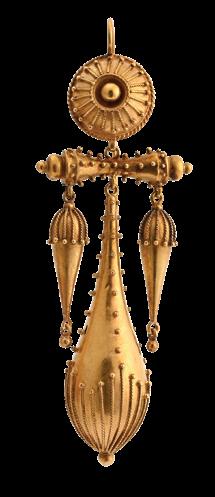
Kiyomura has had a similar experience: “While sales are still steady, my clients seem to be more discerning when looking for collectible jewelry. Finding the right merchandise to stock continues to be more and more difficult. The demand for the best of the best is very high and commands higher prices.”
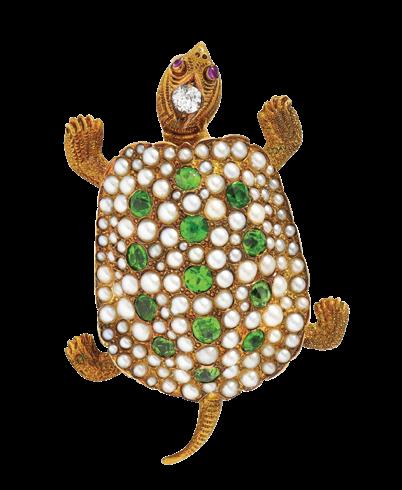
Today’s competitive market has “more players than ever before,” affirms Greg Kwiat, CEO of New York dealer Fred Leighton. “To be successful, it’s important to offer the client a level of jewelry curation — a world-class collection — and to deliver an exceptional experience.”
Kwiat expects “some robust buying and selling” at the 2024 show. All five dealers say having the fair in the same location as the Couture show helps with business.
“I am looking forward to building on the crossover interest that started last year,” remarks Kiyomura. “This show presents a great opportunity to meet quality retail stores around the country and sell to new clients who previously had never visited the show.” Here are some of the expected highlights.

LATE VICTORIAN
“Late Victorian is witnessing a resurgence in Etruscan revival pieces with granulation and other intricate goldwork that isn’t flashy, [pieces that are] easy to wear yet still collectible,” says Cronan. She also cites rivière necklaces in colored gems and diamonds from the Victorian era.
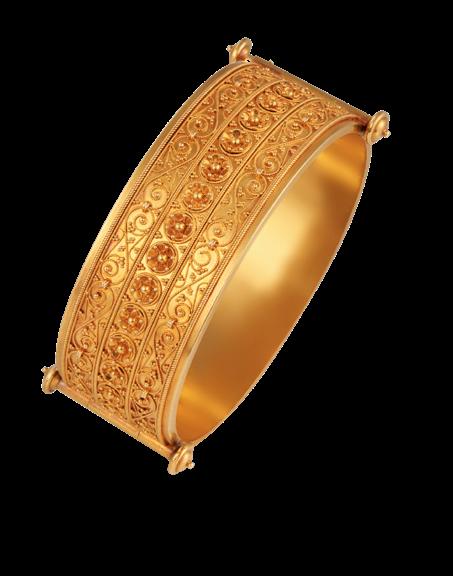
Kiyomura highlights this period as well. “We continually do well with the more unusual and rare Victorian pieces in all categories of jewelry, and that hasn’t changed.”
Kwiat also mentions rivière necklaces, as well as collet-set diamond earrings from the 19th century.
SIGNED PIECES
“Signed pieces by the great jewelry names continue to be in demand, with strong prices,” says Kwiat.
Orlando specifically points to Cartier, Tiffany & Co. and Van Cleef & Arpels as houses that are popular for their pieces’ craftsmanship and historical significance.
DECIDEDLY DECO
Art Deco is always desirable, and 2024 is seeing a focus on key items from this era.
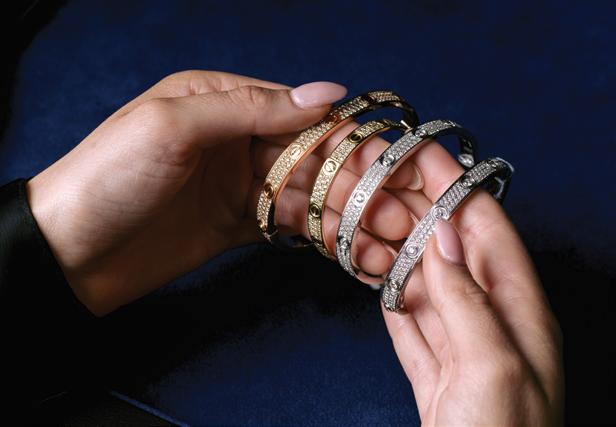
“I continue to sell wonderful Deco pieces, particularly diamond line bracelets or more intricate bracelets from that period,” says Cronan.
Kiyomura also foresees line bracelets as a top seller from the era, while Orlando and Richardson report ongoing sales of Art Deco engagement rings.
EVERYDAY WEARABLE
Clockwise from top: Vintage watches and Cartier Love bracelets at the Las Vegas Antique Jewelry & Watch Show; Etruscan revival bracelet from Sandra Cronan; French circular link bracelet from Fred Leighton, c. 1940s; Riker Brothers Art Nouveau turtle brooch from Wilson’s Estate Jewelry; Victorian Etruscan revival earrings from Sandra Cronan.
“Charms, talismans and gold chains, particularly paperclip links and chunky curb styles, are favorites from different eras [and] continue to evolve,” says Richardson. “The layered necklaces have spilled over to layered bracelets in a plethora of styles.” At her store, “rings are perennial favorites. Vintage styles with lots of color that look like irresistible pieces of candy on the hand are having their day.”
For Cronan, items like ultra-long Victorian guard chains are selling, with customers styling them as body chains. Also popular are gypsy rings from 1880 to 1915, which have a contemporary feel but more character than today’s models.

Kiyomura mentions 1970s and ’80s jewelry: Bulgari’s signed Monete necklaces and anything Aldo Cipullo made for Cartier. “Even with the prices of gold going up, customers feel they can wear these pieces more easily than those from earlier periods,” she says.
Kwiat adds that he’s been “seeing a lot of interest in bold, yellow gold styles, including chunky bracelets and earrings.”


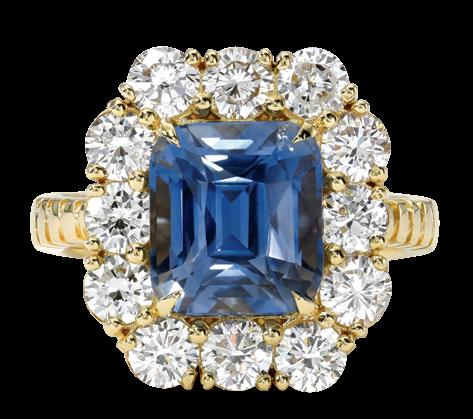
MAKING THE QUESTION POP
Colored-gem engagement rings are a refreshing way for couples to personalize their love story. By Beth Bernstein
Designers, retailers and the end consumer are all saying “I do” to colored-gemstone engagement rings. The growing desire for brightly hued stones in bridal stems from a combination of factors: Couples are searching for something distinctive to symbolize their relationship, vivid color is trending generally in all classifications of jewelry, and the controversy over lab-grown diamonds continues. Here, we talk to retailers and designers about the trend of colored-gem center stones, who’s choosing them and why, the most up-and-coming hues, and whether this direction in bridal is here to stay.
A new generation
“The desire for colored gemstones has been inching its way to popularity over the past three to five years,” says Lauren Wolf, designer of Lauren Wolf Jewelry and owner of retailer Esqueleto, which has stores in California and New York. “The white-diamond trend has fallen off, and the consumer is looking for something more personalized and unique to them.”
Olivier Reza is seeing a somewhat slower shift. “Habits are not changing overnight, but colored gemstones in bridal are increasingly considered an option,” says the designer
and owner of multigenerational New York jeweler Reza, which his father originally started in Paris. “[The gemstone trend] started around the millennium as colored stones began showing up more in fine jewelry. The ’90s were a decade dominated by diamonds, but in today’s market, every classification of jewelry features color, [and this] has also influenced engagement rings.”
As for who’s buying these rings, “the newer generation definitely has more interest in them,” reports Reza. “They were raised with color, personalization, and rule-breaking fashion.”
Michelle Berlinger of Los Angeles-based jewelry brand Berlinger agrees. “For us, it’s the millennial or Gen Z shoppers who are all about individual style, [who] are drawn to more unexpected pieces or customization in their jewelry, and who want to stand out from their friends and peers.”
Replacing diamonds?
What makes couples choose colored stones over diamonds?
The individuality factor is a strong one, according to designers, as is the sentimental factor.
“It revolves around personal preference, which often stems from seeing a family member wear a certain stone over the
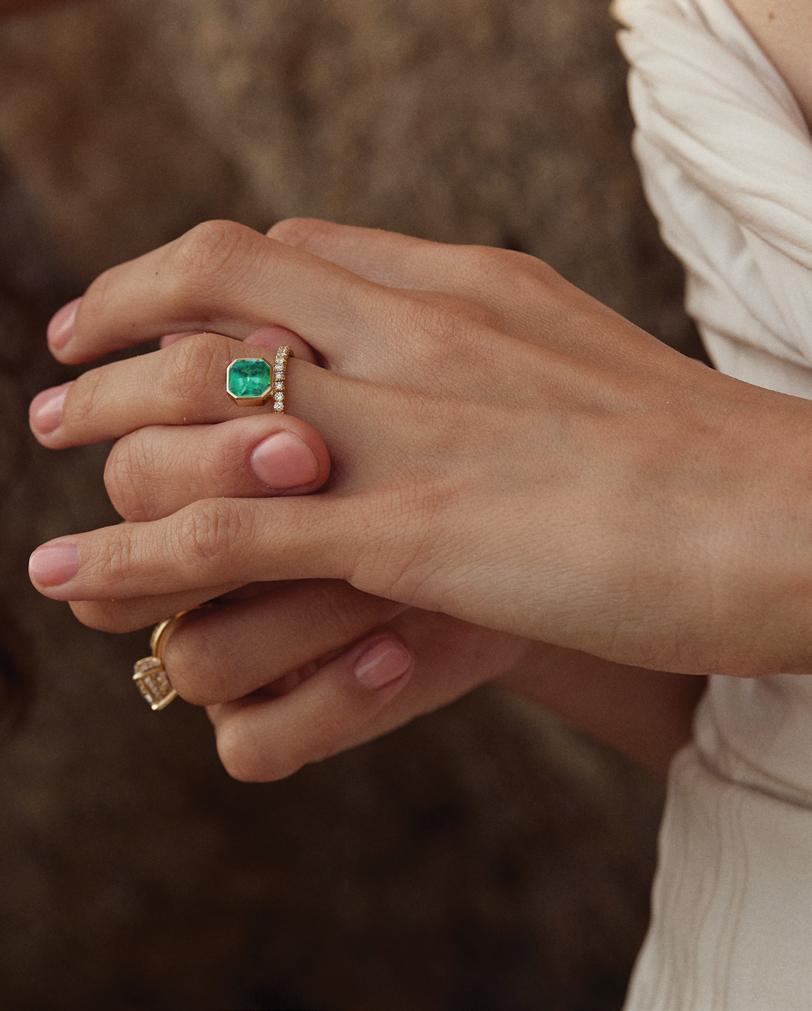
“For us, it’s the millennial or Gen Z shoppers who are all about individual style, [who] are drawn to more unexpected pieces or customization in their jewelry”

years,” explains Grace Lee of the eponymous Los Angeles-based brand. “Sometimes it correlates to one or both of the couple’s birthstones.”
Reza echoes that sentiment.
“Colored gemstones are a way to express the wearer’s inclination for choosing hues that make each ring more unique. Additionally, the wearer might gravitate toward gems that are rarer, making them a better investment.”
Berlinger has a different take: “There are still lingering ethical concerns around diamonds, and if the bride-to-be wants a natural and not a lab-created stone, [couples] tend to turn toward colored stones as an alternative.”
Wolf — who also co-created and organizes jewelry fair Melee the Show — concurs. “The hype around lab-created diamonds versus natural diamonds has forced some consumers in a different direction, opting out of a diamond altogether.”
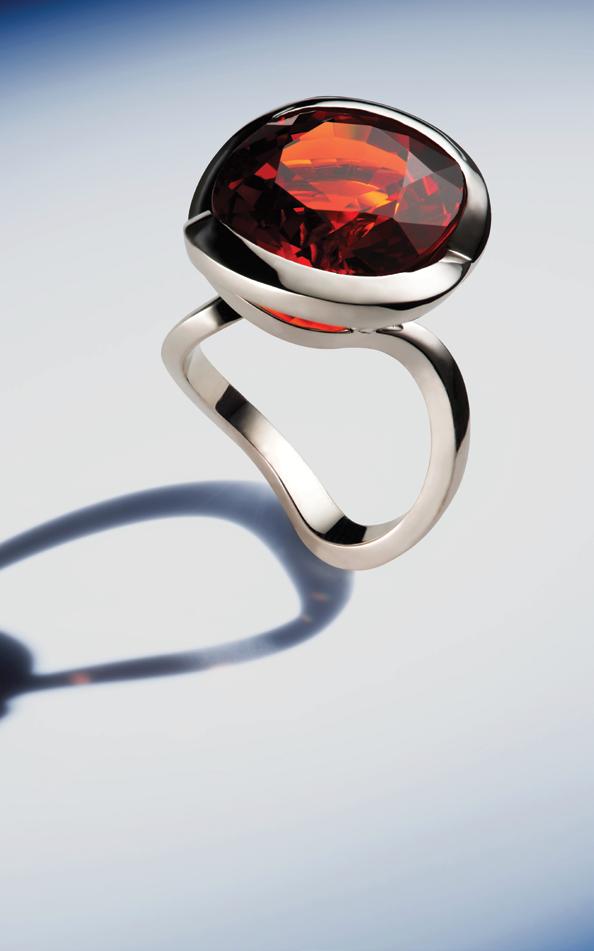
Sapphires, emeralds and accent stones
Historically, sapphires and emeralds were front and center in the antique and vintage rings that graced nobility, Hollywood royalty and socialites. Think actresses Joan Crawford, Carol Lombard, Myrna Loy and Jean Harlow, all of whom wore sapphire engagement rings. Duchess of Windsor Wallis Simpson and former US First Lady Jacqueline Kennedy owned emerald engagement rings — and of course, there’s Princess Diana’s famous sapphire engagement ring, which Princess of Wales Kate Middleton wears today.
Back then, these gems were not as “alternative” as they are today; years of De Beers’ “A Diamond Is Forever” campaign have since changed the norm. Now, however, we are starting to view colored stones as trend-worthy again.
“There is a huge uptick in sapphire for center stones, with a major focus on blue sapphires, [but also] sapphires in lighter blue, green, purple and color-changing variations,” says Wolf.
While Reza has “found sapphires and emeralds to be an especially popular choice among our clients…we also see them moving toward different options.”
Berlinger cites sapphires and emeralds as well, but says her customers “are asking for morganite and aquamarine for the color and more accessible pricing.”
Style-wise, multi-stone rings tend to dominate, say designers, though there is interest in singles as well.
“Diamond accents are still important to elevate the look, so we’re primarily seeing halo engagement rings with colored gems as center stones,” reports Berlinger.
For Wolf, meanwhile, “solitaires and three stone-rings continue to be the options in highest demand.”

Lee has found that “clients who choose colored gemstones tend go much larger, in the 3-carat-plus range. Most popular are toi et moi or multi-stone settings with three or more stones.”
Ongoing value
Retailers agree that margins for top-grade colored stones are around the same as for diamonds, and foresee bridal shoppers choosing these gems for some time to come.
“There is good value in purchasing a sapphire ring for your forever ring,” asserts Wolf. “The one-of-a-kind nature of sapphires and emeralds will help continue the trend of bridal jewelry for colored stones.”
The increasing emphasis on design will also keep it going, Berlinger predicts. “Consumers will continue to seek out alternative stones as the collective style of engagement rings focuses less on diamonds and more on the style of the ring itself.”
Reza agrees. “The shift to [rarer and more] uncommon gems and the preference for individuality and one-of-a-kind designs is inspiring much more color and diversity in the future of bridal jewelry.”
GLAM FOR THE GUYS
Men’s jewelry is a fast-growing category, whether it’s signet rings, curb links, or blingy statement pieces. By Cathleen
McCarthy
“[Clients] in their teens to early 20s... are really open to taking risks. The crazier, the better”

house’s jewelry is aimed at men. As of this year, it offers about 75 styles for a male clientele. While masculine elements like woven sterling chains are what anchor this selection, John Hardy has always leaned more bohemian, with designs like its iconic Balinese dragon and increasing shots of color in the form of turquoise and lapis. Other brands that were dabbling in the category are suddenly getting serious about it. In January, Lagos introduced its first dedicated men’s collection, “Lagos for Men,” and last year, Louis Vuitton hired music artist Pharrell Williams to design a colorful new high-jewelry collection British designer Stephen Webster, whose jewelry has a colorful goth vibe popular with rock stars, has always

had a strong following among men. His core male customers these days, he reports, are “younger than they used to be, probably 25 to 40.”
That is the age group Cameron styles most often, The Bachelor franchise being her mainstay. “Many guys in their late 20s to early 40s are still on the fence about adding jewelry,” she says. “But because they see it more often now, I think it’s getting easier for them to take a risk.”
There’s less hesitation in the younger crowd, though. “Guys in their teens to early 20s...are really open to taking risks,” Cameron observes. “The crazier, the better.”
Retailer Brilliant Earth, which bases its brand on sustainability and transparency, is taking its cues from that youthful demographic.
“We’re inspired by the risk-taking and bold self-expression of younger millennial and Gen Z customers,” says Ryan Atlas, its senior director of product design. Those customers are looking for variety, “whether it’s a personalized engraving, an ID bracelet, a pendant necklace, or a signet ring worn on the pinky finger.”
Quiet, bold and stacked
Today’s generation takes its cues from social media. “Micro-trends on Instagram, and especially TikTok, have an influence on style preferences, even for slightly more considered purchases like fine jewelry,” Atlas says.
One such trend is what he calls quiet luxury.
“Quiet luxury can mean a classic Cuban-link bracelet or even a new interpretation of the

CHAIN MALE
Bold gold chains for men date back to Elizabethan days, but the silver link chain as men wear it today — peeking out of a cuff or collar — dates to the early 1950s.
Actor Marlon Brando can be seen in 1954 wearing a T-shirt with a chunky chain-link bracelet and bold gem-set ring. Throughout the ’60s, fellow film star Paul Newman wore a silver chain bracelet on one wrist, a watch on the other, a wedding band on the left hand, a signet ring on the right, and sometimes a pendant necklace.
In other words, today’s men are styled a lot like they were 60 to 70 years ago. But there’s a new willingness to experiment with jewelry across gender lines — especially among Gen Z.
Retailers willing to market jewelry online in a more gender-fluid way may find they can increase sales to men just by altering descriptions, adding size options and model shots, or following Brilliant Earth’s lead with a “Gender-neutral rings” landing page.

tennis bracelet, such as our black-diamond 8.5inch tennis bracelet.”
David Yurman’s popular Curb Chain collection, based on the classic Cuban link, has taken on a more streamlined silhouette, says Tucker.
“On the other end of the spectrum,” adds Atlas, “the ‘bolder is better’ trend translates to... rings of 5 millimeters [or more] in width.”
In that vein, “men are tuning in to stacking,” Tucker reports. “We’re also seeing them pull silver, white, yellow and rose gold bracelets into the same stack.”
Another trend he cites is “combining chunky chains and flashy statement bracelets with minimalistic styles like leather or beads.”
While Cameron is still stacking jewelry on female clients, she’s starting to see a shift among men to one or two standout pieces. “I think men are getting comfortable with the fact that jewelry...is getting bigger and bolder,” she says. “But we don’t have to go over the top to make a statement.”
Gender
neutrality
Gender divisions in jewelry have begun to blur. Brilliant Earth has a page of gender-neutral rings. And David Yurman is offering “dualgender” collections like its Sculpted Cable and DY Madison chains, sized for men as well as women.
Cameron frequently pulls from women’s brands to find unusual materials — including pearls — or “a chunkier look” for the men she helps dress. They rarely ask where she gets her jewelry. “A lot of my male clients like women’s rings,” she says. “It’s hard to find men’s rings out there.”
Last year, Webster launched a collection of brightly colored enameled rings in collaboration with rapper and singer Machine Gun Kelly. They quickly sold out. “I’ve seen just as many guys as women wearing them,” Webster says. “When I see that, I know the jewelry space is shifting.”
Shopping channels
While his customers in stores and showrooms are still predominately female, Webster says his online sales are about 50-50. “E-commerce is disproportionately higher for men than any other channel, whether it’s our retail or our wholesale business.”
In an effort to reach the male customer who’s buying online, Webster opened the No Regrets Lounge in Nashville’s Diamond Cellar in 2022. Along with having Webster’s jewels on display, the lounge offers live music and a lively bar scene. No Regrets created exactly what Webster and Diamond Cellar owner Andy Johnson wanted: a male-friendly buzz. “If you’re a guy in Nashville, you’ll feel perfectly comfortable going in there,” Webster says. “It’s a bar!”
YURMAN’S
VAULT
David Yurman launched its first men’s high-jewelry collection this past January, and while the brand is known for its conservative look, The Vault is anything but. Its flashy colored gems include black opals with diamonds and multi-hued faceted stones. Another launch quickly followed: the more accessible, mainly metal Chevron line. The company tapped actor and film producer Michael B. Jordan as brand ambassador for both. Jordan “carries a certain gravitas,” says David Yurman’s Lee Tucker. “He is effortlessly confident and timeless in his demeanor and style.“ Jordan has become known for carrying off edgy fashion with masculine cool on the red carpet. At last year’s Oscars, he wore two Tiffany & Co. Bird on a Rock brooches and a diamond tennis bracelet with his Louis Vuitton tux. The star has also shown up in red, blue and yellow designer suits. But Chevron seems more in line with his everyday style, which — judging from his Instagram feed — leans toward T-shirts.
MIX MASTERS
Whether
it’s gold, silver or platinum,
the trend of combining different metal colors is heating up. By Beth Bernstein

have successfully been creating such pieces since
then as part of their aesthetic, particularly in high-karat gold and oxidized silver. Recently, more and more designers have found it necessary to combine yellow gold with silver due to the rise in the price of gold, while others are doing it to add dimension or tactile interest to their styles.
“Mixing different-colored metals gives depth and can accentuate the nuances that make a piece special,” explains Laura Freedman, founder and CEO of Broken English Jewelry in Santa Monica, California, and New York.
Quadrum Gallery in Boston, Massachusetts, represents “several artists that have been mixing metals for a long time,” says director
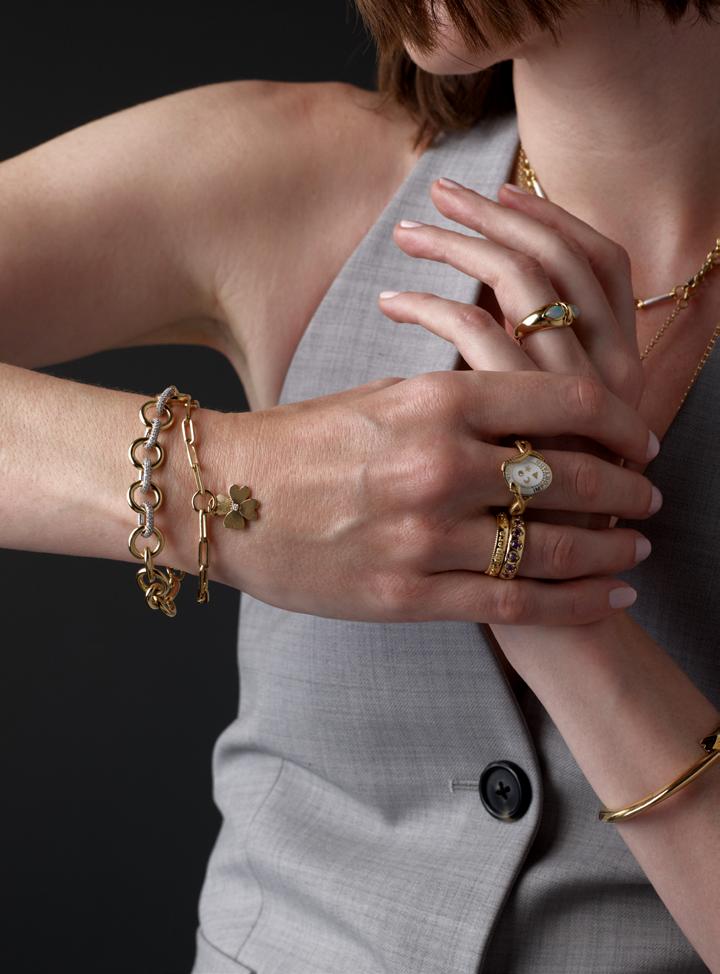
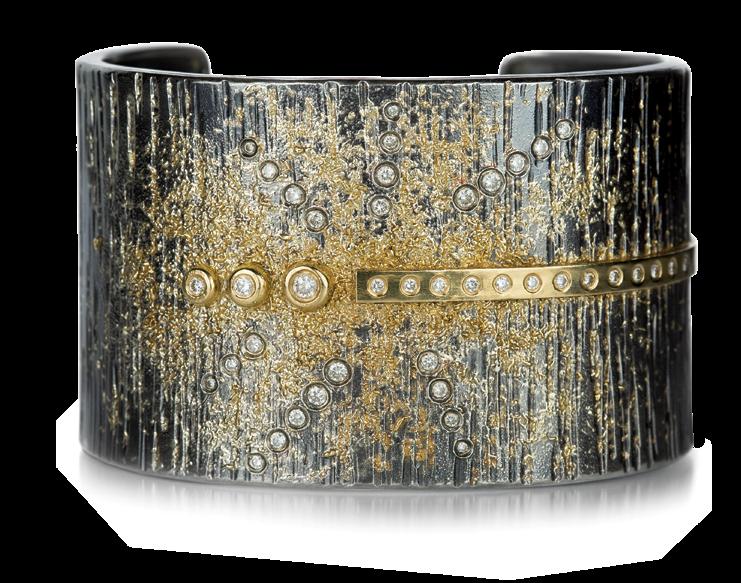
“Mixed metals work best in more bold designs, such as a statement ring or large cuffs, lending character and beauty”
Sia Maravelias. “Each of these artists uses the contrast as a key element in the design and composition of their collection. Today, we are seeing emerging designers try new elements and combinations, which is also helping ignite the trend.”
Ready to mingle
Which companies are at the forefront of this aesthetic? Pomellato and Bulgari are high on the list, according to Anne Russell, executive vice president of Hamilton Jewelers, which has stores in Princeton, New Jersey, and Palm Beach, Florida. “And of course, David Yurman, one of the original designers to mix silver with yellow gold. The combination is practically synonymous with their brand.”
Maravelias cites Kate Maller, Annie Fensterstock, John Iversen, Amáli Jewelry, Ananda Khalsa, Pat Flynn, Jamie Joseph, and Variance as brands that work primarily in multiple, contrasting metals. Those that do best in Freedman’s store include Shay, Milamore, Prasi, Kloto, and Foundrae.
Both Freedman and Maravelias find that clients looking for versatility and stackability are the ones most drawn to mixed metals.
Sometimes it’s a slightly edgier customer, says Freedman. Maravelias observes that for “clients who wish to stay current with their jewelry choices,” this is “an easy trend to make one’s own, with so many wonderful options.”
Making a good team
While 18-karat yellow gold and oxidized silver is the most popular pairing, says Maravelias, “many artists do work exclusively in gold, mixing karat and color with beautiful contrast.”

combos succeed at different price points: sterling silver pieces with yellow gold accents at the more affordable end of the spectrum, and “more of a high-jewelry piece that uses platinum to offset a rare gemstone at the high end.”
As far as types of jewelry, “rings seem to be the easiest to understand,” adds Russell. “We have seen platinum heads and 18-karat yellow gold shanks becoming very popular in rings.”
For Maravelias, “mixed metals work best in more bold designs, such as a statement ring or large cuffs, the mix lending character and beauty, while the versatility of silver and gold together make a winning combo for everyday staples.”
Certain metal pairings work well with either gemstone accents or larger center stones.
“Diamonds and mixed metals are always desirable, but it’s all about the application,” comments Freedman. “I wouldn’t get bogged down by rules, but rather see where…the designer’s imagination takes them.”
Maravelias concurs. “There are no rules in the alchemy of mixed metals, but some gemstones do thrive in a multitude of settings. Diamonds top the list with the sparkle of the sun in gold or the stars in silver. Multiple gemstones feel at home in any metal, while pyrite stands out as a gem that seems to be simply destined for a mixed-metal masterpiece, its own color spanning both gold and silver naturally.”
FIVE DISPLAY IDEAS FOR YOUR STORE
1
Create a display in which you stack different metals to showcase how good the colors look together.
2
Try to add in pieces that have textural contrast and dimensional interest as well, with details like oxidized silver accenting the gold.

3
When in doubt, show pieces with diamond accents. Diamonds highlight all the metal colors.
4
In your marketing photos, pile on different metal combinations and work with your customers on building their own personalized wardrobes.
5
Show one statement piece with artistic design and handmade craftsmanship that your customers can either wear alone or layer with other items.
LOOKING WITHIN
Designer Jillian Sassone offers ‘sparkle with substance’ at Marrow Fine in southern California and Chicago. By Joyce Kauf


Jillian Sassone believes “jewelry has to be more than pretty.”
The founder and creative director of Marrow Fine began her business reimagining the “good old bones” of heirloom jewelry into exciting new pieces.
“Our message is sparkle with substance,” says Sassone, who is also known for her signature stacking rings and bridal designs. She credits social media with driving brand awareness. Celebrities like Margot Robbie, Megan Fox and Machine Gun Kelly are among her many fans.
MAKING THE ROUNDS
Sassone and her husband Tim, who is also her business partner, take a proactive in-person approach to building their business across the country. “We have a traveling trunk show every weekend except holidays,” she says. Two alternating teams travel to major cities and some second-tier cities that have few independent jewelers.
“Trunk shows are a great way to test the market,” says Sassone. Chicago was the company’s “top performing market from day one,” and a deciding factor in the couple’s decision to open a third location — the first outside their California base.
Marrow Fine launched in 2017, with the first retail location opening in San Diego County’s Del Mar neighborhood in 2019, followed by Newport Beach in 2021. In November 2023, the couple opened their newest branch on Chicago’s Gold Coast.

Sassone prefers to call these locations “showrooms” rather than stores. She recalls the jewelry experience being “a little daunting with staff who size you up the moment you walk in.” However, “a showroom is where you come to spend time to get inspired. Even if you don’t buy that day, you leave with an impression that makes you feel better.”
LUXE DECOR IN THE WINDY CITY
The Chicago showroom pays homage to the city’s Art Deco heritage. With its monochromatic red setting, its tiered, embossed velvet sofas, and its scalloped wall vitrines set off by terrazzo flooring, the showroom exudes the ambience of a luxurious hotel lobby.
Although each location differs in color and feel, they all feature a “babe cave” for private consultation. In Chicago, the secluded, velvet-lined alcove resembles the inside of a ruby. To mark the opening of that branch, Sassone created an exclusive band with the city’s name engraved on the back, giving it a special appeal for “people who are proud to be from Chicago.”
While she’s been focused on getting that store up and running, her short list of next cities includes Dallas, Boston, and Washington, DC.
“Sometimes people stop me on the street and ask if I’m wearing a Marrow,” says Sassone, who started at her kitchen table. “It’s such a great compliment when people recognize your work. It’s the feeling of being in on something.”
PARTNERS IN SHINE
Collaborations between stores and designers are becoming more popular than ever. Three retailers give us the inside scoop on their lucrative team-ups. By Beth Bernstein

The Seven: A flexible model
“Collaborating on exclusive designs provides both stores and designers with a competitive edge, enhancing the overall experience for the collector,” says Camille Zarsky, owner of The Seven in West Village, New York. “By having one-of-a-kind pieces or offering designs specific to our store, we attract and retain clients long-term.”

“This shift reflects a bigger trend in which brands are providing a more personalized approach”
For Zarsky, “one of the most exciting changes in the past few years is that independent designers have the capacity to produce smaller batches and to craft one-off pieces. This flexibility allows the designers we work with to explore their creativity, and it helps us to present our clients with more one-of-a-kind pieces, allowing them to express their individuality and tell their stories through their jewelry. This shift reflects a bigger trend in which brands are providing a more personalized
approach, recognizing the value of offering unique experiences. [This] is so important in today’s market, in which more and more clients want something that no one else has.”
Do the designers have the freedom to maintain their signature styles? “Always,” Zarsky asserts. “We choose the designer for their point of view and then work with them on pieces that reflect their sensibility, but perhaps in a color or shape that they haven’t done before. Another way in which we collaborate is to incorporate a meaningful sentiment or stone that a client wants to highlight.”
One example she cites is her collaborations with Los Angeles-based designer Emily P. Wheeler. “These have drawn a lot of interest from our collectors, because they are so identifiably Emily, but we work on exclusive palettes, sizes, shapes to make them unique to The Seven.”


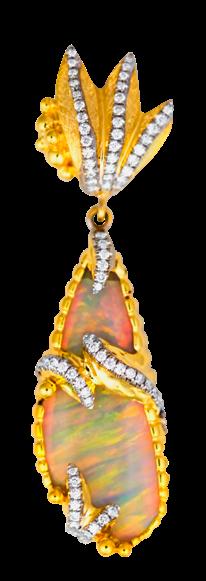

Marissa Collections: Standing out from the crowd
At Florida jeweler Marissa Collections, the collaboration story is a bit different.
“It started back in 2005,” recalls Jennifer McCurry, buyer and lead fine-jewelry curator for the company, which has stores in Naples and Palm Beach. “We were seeing all of these great one-of-a-kind pieces from designers at shows like Couture in Las Vegas. These were striking and stood out, so instead of continuing to buy into just the core collections, we began to purchase these one-offs. Both of our stores are in small communities; therefore, women don’t want to feel as if someone else is going to be wearing the same piece. They desire pieces that are unique to their personality that no one else will have. We started to move more toward this point of view, and it has grown and been successful ever since.”
That kind of targeted service extends to the way she and her team shop jewelry shows. “We will have a list of our clients, and when we see these one-offs, we will send them photos right away and ultimately wind up buying pieces for many of our customers right at the show.”
Social media platforms like Instagram and TikTok enable women to see all types of jewelry from myriad sources, she notes. “This is one of the driving forces behind our clients’ desire for more individualized pieces… rather than styles that everyone else can own.”
She has brought in oneof-a-kind contemporary pieces from brands such as Sylva & Cie, Irene Neuwirth, Arunashi, and Victor Velyan, and has turned to New York estate jeweler Fred Leighton for authentic Georgian, Victorian, Art Deco and Retro styles. “We also work with designers to reinvent and create a new style just for the store. Many of our designers are really open to this as well.”
One such collab is an exclusive pink colorway called “Marissa Pink,” says McCurry. “[The designers] add this colorway to enamel or [use] a special pink gemstone combination in a specific piece. Our loyal clients get excited about collecting these new collaborations, and ultimately, they
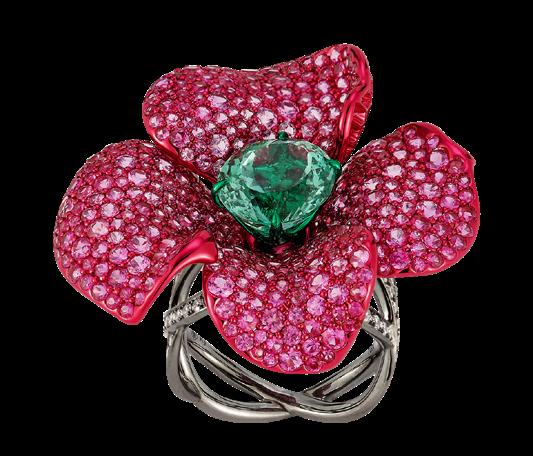

Tiny Gods: Merging aesthetics
The boom in online shopping and marketing has played a significant role in the rise of collaborations, according to Mary Margaret Beaver, owner of Tiny Gods in Charlotte, North Carolina.
“Customers have more accessibility to multiple jewelry stores due to social media and a greater online presence than ever before. Therefore, retailers are looking for noteworthy ways to have their product offerings stand out,” she explains.
“Commissioning special pieces from designers that are unique to Tiny Gods is fun, and it’s also an opportunity to strengthen the relationship with these brands, which always sets us up for mutual long-term success.”
Over the past few years, designers have become more willing to accommodate retailers’ requests for both exclusive items and special client orders, she reports. “The way we work with our designers is to modify core pieces in a way that resonates more with my clientele. We will create different colorways or different versions of an existing piece, which will then only be available at Tiny Gods.”
She makes sure to choose “brands with extremely strong signature styles, and give them the freedom to branch out and work with us on different projects that will result in the look and feel that will also echo the ethos of our store.”
Beaver has a solid list of such partnerships. She worked with Mexican jewelry artist Daniela Villegas to choose the colorway and gemstones for a one-of-a-kind beetle ring, and commissioned a signet ring from Los Angeles-based company Retrouvaí with the message “I see you and I love you.” Beaver also collaborated with Parisian brand Rainbow K on its Ball Chain necklace using “a custom gold color combination and a different number of pavé balls” to appeal to her clientele and with London-based jeweler Ananya on an exclusive colorway for its Chakra bracelet.
It’s not just brands, either. “Stephanie Anders, a world-renowned piercing artist, does three-day piercing residencies at Tiny Gods. I decided to ask Stephanie to work with [New York-based jeweler] Sorellina, which creates studs that all my clients love. They merged aesthetics, and I introduced a six-piece capsule that launched in the fall of 2022 with an in-store event.”










A CONSTELLATION OF CREATIVES

Jewelry historian, author and writer Beth Bernstein talks about her new book, Jewelry’sShining Stars:TheNextGeneration,45 VisionaryWomenDesigners, which intermixes personal anecdotes with details on these forward-looking artists’ inspirations and aesthetics.
By Phyllis Schiller
This is your second book about jewelry designers. How did you decide on these 45 women? I always knew that at the 10-year anniversary of the first book [Jewelry’s Shining Stars], I would do a second book, similar to the first. I kept making a list, and it grew from 25 into 45 [women] designers who could ignite the same type of passion in me again, who challenged the status quo. I wanted it to be a mix of emerging up-andcomers, international designers, some further along in their careers [but] just opening up more accounts in the US, [and] those from different cultures. [Each of them] had a very distinctive


point of view, yet as a group, they were changing the course of jewelry and, as I say in the book, shaping its present and future.
The women designers in the book are visionaries, breaking down boundaries and helping to form the tastes, styles and standards of the self-purchaser, women who have the confidence to buy jewelry for themselves and prefer gifts that connect to the soul and character, and [that relate] to a significant time in their lives.
How closely do their creative processes and personal relationships with jewelry intertwine with doing this as a full-time career?
Quite a number of the women started out very young, making jewelry and unexpectedly selling it in their teens to local stores, and then went on to learn techniques and figure out their aesthetics as they went along.... Others in the book had very different careers before making the move into jewelry design. Many of these jewelers had a passion for jewelry from the time they were young, but didn’t know they could make a career out of
it and then finally took the plunge. Others had families in the business but went on to try other careers before coming back to what they knew best and what they grew up around, realizing it was part of their DNA.
Were there any surprises in learning about these designers and their work?
Yes, it was surprising to me to discover just how many of the designers learned to work at the bench and learned different processes as they continued in their careers, and did so much of the work themselves. I knew about some of them, but to find so many who were true goldsmiths, who could do enameling or engraving and create new techniques based on traditional ones and then turn them into something so relevant for the women of today yet timeless, so they could go from one generation to the next was one of the most satisfying and joyful surprises.
What has changed in the way women jewelry designers make their mark today?

I think there are many more women designers today than 10 years ago, and those in this book are irrepressible and formidable and independent. They have confidence that allows them to try different methods of branding, selling and marketing. There were fearless fledgling women designers in the first book, but they were more tentative and took more time to evolve. Happily, they are all thriving now, and if they hadn’t been in the first book, I would have put them all in this one. But there are definitely more opportunities today for selling and getting their name out there on social media, and having their own websites, trunk shows, pop-ups, different types of experience parties and, yes, traditional stores.
How would you define a “collectible” when it comes to modern jewelry designs?
Pieces that combine art, function and wearability, offering a glimpse into the designer’s distinct aesthetic [and] culture, and how [this] distinguishes and reflects their jewelry designs. No matter the approach, technique or sensibility, all the designers in the book are creating a jewelry legacy for their clients.
Jewelry’s Shining Stars: The Next Generation, 45 Visionary Women Designers by Beth Bernstein is being published in June by ACC Art Books.
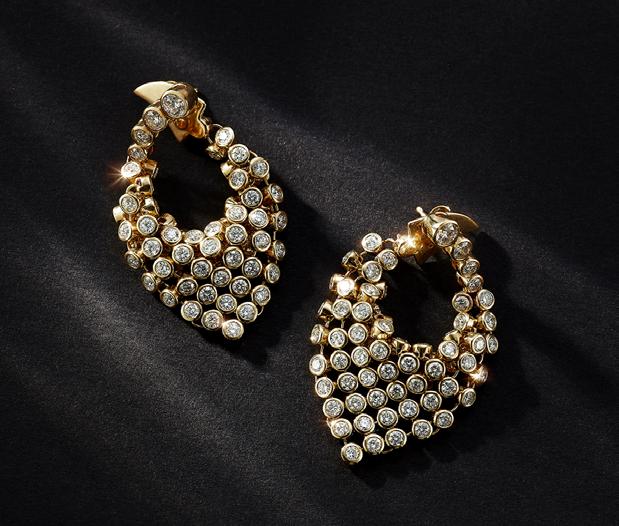
DRESSED TO KILL
The rise of the Mob Wife aesthetic means statementmaking maximalist jewelry is back in business.
By Rachael TaylorWhen Lady Gaga embodied the big-haired, cripplingly adorned Patrizia Reggiani for her role in the film House of Gucci, she pulled the trigger on a new sartorial style that has since been dubbed “Mob Wife.” And the better half of this trend is most definitely the jewelry.
“Think of The Godfather, The Sopranos and Goodfellas… [it’s] power [and] confidence wrapped up in femininity,” declares Clémence Devaux, who heads up the jewelry department at auction house Catawiki. It recently curated an auction dedicated to the trend, with bold gold jewels and attention-seeking 1980s-inspired designs.
“This style is the opposite of quiet luxury and invites people to be courageous and stand out,” she says.
It is not so much that jewelers need to create new designs to fit this theme; they can draw on existing collections or vintage designs. Supersized hoops, heavy chains, bold cuffs and look-at-me cocktail rings all work. Yellow gold is the metal of choice for this trend, and layering is vital to unlocking the look. When embracing Mob Wife, more is more…and probably still not enough.
“Layer your necklaces, stack your bracelets and don’t hold back on those rings,” Joy Haugaard, founder and creative director at New York brand Lionheart, advises clients. “Mob Wife-inspired jewelry is more than just accessories — it’s a story of luxury, power, boldness, cultural depth and unapologetic excess.”
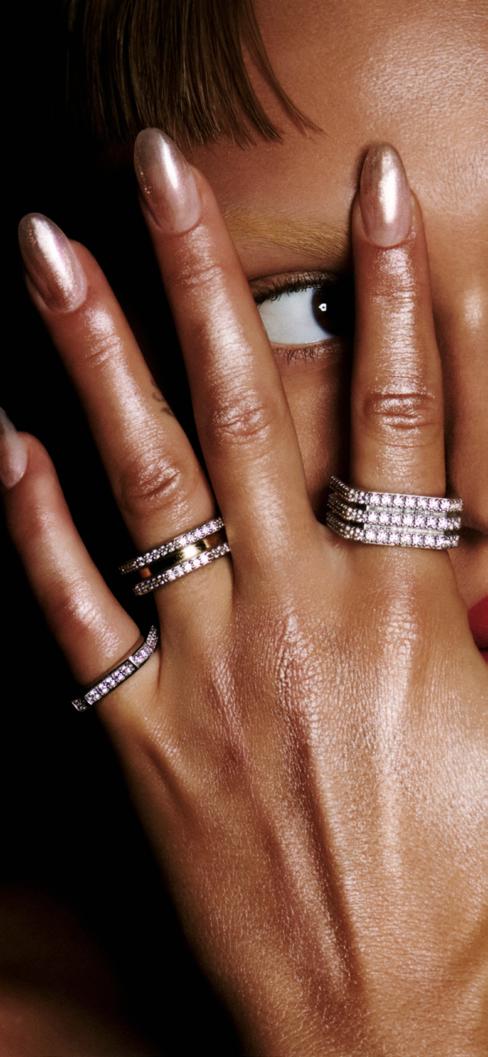


Susana Martins
The One huggies in 18-karat gold with diamonds and black enamel.


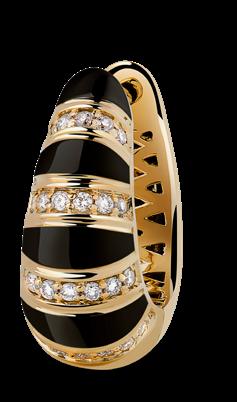
Karina Brez LUV bracelet in 18-karat yellow gold and diamonds.

Briony Raymond Sloan signet ring featuring a 2.50-carat, rose-cut diamond in 18-karat yellow gold.

886

Suzanne Kalan Fireworks rings and bracelets in 18-karat yellow, white and rose gold on model.
Lionheart Cassandane Sun medallion with diamonds in 14-karat yellow gold. Tutamen necklace in 18-karat yellow gold with diamonds. IMAGES: ONDYN; EMILY
THE MODERN ALCHEMIST
Design prodigy and metallurgist Adam Neeley combines art and nature in his works, which are the focus of a new retrospective.
FBy Sonia Esther Soltani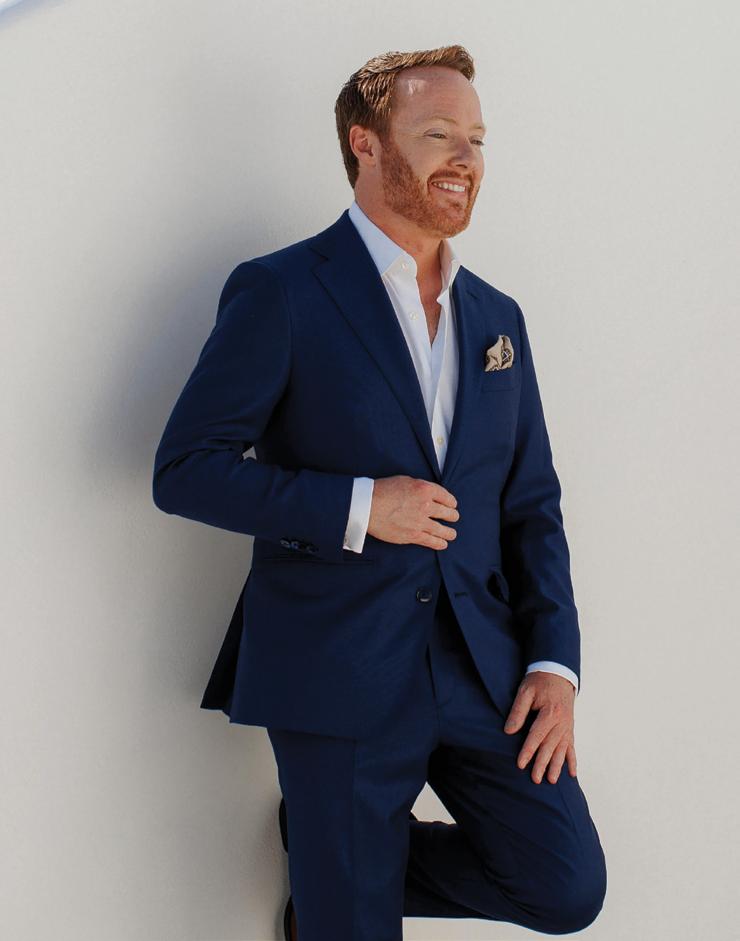
or thousands of years, alchemists have aimed to turn lead into gold. Adam Neeley set his sights instead on capturing the light of sunrise in this precious metal, and this is how SpectraGold and three other custom alloys were born.
Visitors to the Smithsonian National Gem and Mineral Collection can admire Neeley’s South Sea Glow earrings from 2010, the first of his creations in SpectraGold. The jewels feature golden to white pearls, perfectly matching the metal’s ombré effect; they “transition gradually from a rich yellow into a bright white gold seamlessly,” explains the designer, who works in Laguna Beach, California. “Through 185 trials, I’ve perfected the alloy with increased hardness and workability.” The gold parts he uses are hand-fused and forged; there is no soldering involved, and they require over 80 hours to produce.
Neeley’s masterpieces have been lavished with awards for their remarkable color palettes and use of extraordinary gemstones. Having received dozens of prizes from the American Gem Trade Association (AGTA) and the Manufacturing Jewelers & Suppliers of America (MJSA), Neeley is now the subject of a retrospective exhibit.
“Modern Alchemy: The Fusion of Art and Nature in the Jewelry Designs of Adam Neeley” runs through July 29 at the Laguna Art Museum (LAM), showcasing his most iconic creations. The curator is art historian and goldwork scholar Timothy Adams, who specializes in the work of Peter Carl Fabergé.
“We collaborated on the selection of pieces from the last 25 years,” relates Neeley. “Our intent was to explore my early journey as a jewelry artist, feature key themes that reflect my evolution as a designer and metallurgist, and highlight several of my award-winning pieces.”
Early talent
The exhibit offers a cohesive overview of Neeley’s career, starting with his youth collecting rocks in his native Colorado and making his first pair of earrings at age 12 for his mother, using lapis lazuli and silver. As a teenager, he apprenticed with silversmith Jim Walker and started selling his jewelry at a local arts festival. His first award-winning piece was the Rings of Saturn pendant, which he made out of ammolite and sapphires when he was 17. A work of tremendous maturity and confidence, it shows off his enthusiasm for fossilized gems and ideal harmony. “Having explored Southwestern motifs in my early work, [this] pendant was when I began to explore the possibilities of contemporary design and abstract minimalism,” Neeley shares.
The precocious artist won a full scholarship to the Gemological Institute of America (GIA), graduating in 2003. He then studied design and advanced techniques with master goldsmith Gio Carbone at one of Europe’s top institutions, Le Arti Orafe in Florence, Italy. He completed his formal education and learned computer-aided design at New York’s Fashion Institute of Technology (FIT) before opening his studio on the west coast.
Following the masters
“Modern Alchemy” emphasizes the Renaissance man in Neeley. The jeweler draws inspiration from nature — as seen in his mesmerizing Calla Violette earrings, which feature vibrant garnets in anodized titanium and white gold. A deep appreciation of classic art and avantgarde architecture nurtures his creative process as well.

“I find endless inspiration in the vast tapestry of artistic expression throughout history”

“From the ethereal color combinations of Monet to the dramatic and moody works of Caravaggio, art serves as a boundless wellspring of creativity for me,” he says. “Whether exploring impressionism or baroque periods, I find endless inspiration in the vast tapestry of artistic expression throughout history.”
Other design giants he admires include architects Frank Lloyd Wright and Zaha Hadid. “Wright’s modernist and geometric style, along with Hadid’s organic and radical deconstructivist designs, ignite my imagination.”
It’s been 25 years since the aspiring artist sold his first turquoise and silver pieces in Colorado, and his stated desire “to explore new possibilities and reinterpret the essence of design in my own creative endeavors” remains unextinguished.


ROCKS OF AGES
The new director of Paris’s 300-year-old Musée de Minéralogie wants to get people talking about the wonders of minerals and how we source them.
By Sonia Esther SoltaniAclassic Parisian building erected in 1707 on the Left Bank has been home to one of the most interesting mineral collections in the world since the beginning of the 18th century. Few of the uninitiated outside of France know about it, however. Originally intended to assist mining students in their studies, the Musée de Minéralogie comprises 100,000 specimens, with some 5,000 on display for the general public.
Housed on the second floor of the School of Mines in the Vendôme Hotel and accessible through a majestic stairwell surrounded by classic frescoes, the museum opens into a main gallery with over 60
meters of elegant mid-19th-century wooden cabinets. Visitors experience the collection the same way it was set up in the 1850s.
The museum aims to understand the nature of the minerals, as well as how and where to find deposits of similar materials, and to serve as an inventory of natural resources that’s as exhaustive as possible.
A COLLECTION WORTH SHARING
How to make this vast collection of rocks relevant to contemporary visitors — and spark larger conversations about environmental issues and the jewelry industry — is the mission that the museum’s new director has set for her institution.
“Visitors...ask why I am touching something that is in a museum. I tell them, ‘Please touch it, too!’”

Geologist Eloïse Gaillou worked at the Smithsonian National Museum of Natural History in Washington, DC, and the Natural History Museum of Los Angeles County, California, before returning to her native France in 2014. An expert in opals and colored diamonds, she was the curator of the mineralogy museum before stepping up as its top manager earlier this year. Passionate about education and outreach, Gaillou has already established partnerships with L’École des Arts Joailliers, which has campuses in Paris, Dubai and Shanghai. She is also looking to create strong bridges between the museum and the French jewelry scene.
The collection she wants to open to the broader world includes “a lot of old big rocks, rough stones, gem crystals and beautiful rough diamonds from all around the world — from India, Brazil and South Africa,” she says.
One of the highlights is loose gems from former French royal collections.
“There were not pieces of jewelry, because the French crown jewels were mostly kept as loose gemstones to be reused under different kings and emperors,” explains Gaillou. “They were hiring new jewelers and making new pieces of jewelry during their reign.”




HANDS-ON EXPLORATION
Meteorites also draw some attention — especially the ones that visitors can touch, to their utmost surprise. “When I show this meteorite that is 4.5 billion years old, much older than the Earth, I keep touching it, and visitors look at me puzzled and ask why I am touching something that is in a museum,” she relates. “I tell them, ‘Please touch it, too!’”
Besides this hands-on approach to pieces of the moon or Mars, Gaillou would like the museum to be a conversation-starter about how we mine gems and how this connects to wider economic and ethical considerations about sourcing. The dynamic curator sees the museum’s role as a guardian of oral transmission, not just a keeper of beautiful rocks. Under her inspired direction, the understated museum is certain to become an unmissable destination for mineralogy lovers the world over.
OUTLASTING LAB-GROWN

The colored-stone industry has survived and thrived despite the advent of synthetic gems. Experts believe the same thing will happen with diamonds. By

WRicha Goyal
hile synthetic gems, particularly rubies, have been around since the mid-1800s, they haven’t caused as much disruption to the natural-ruby or broader gemstone industry as lab-grown diamonds have to that of their natural counterparts. Some attribute this difference to the larger scale of the natural-diamond sector. Others cite the overall rarity factor of colored gems — and of rubies in particular, especially in the ancient world — as granting these red stones a cultural prestige that has continued to drive the price upward and increase the gap between natural and synthetic specimens.
Beyond that, the portability of precious gems, combined with their inherent value and beauty, has ensured their rise in demand through the ages, especially during periods of chaos and conflict.
Sikri
THE RUBY PRECEDENT
Throughout history, jewels have contained imitations such as colored glass, sometimes with shaded metallic sheets as a backing. Lab-grown gems, which have the same chemical makeup as natural ones, took things to a new level.
Ruby was the first gemstone to be synthesized. “Irrespective of the period, rubies have always been a high-demand, low-supply item,” explains Anil Gandhi, director of Gazdar Jewellers. “And when desirability for a product outstrips its supply, pushing prices into stratospheric levels, the market seeks replacements.”
Experiments to synthesize gems began as early as the mid-19th century, according to author Joel Arem in his book Gems and Jewelry. The earliest was Marc Gaudin in France, although he never managed to create gem-quality corundum. In the mid-1880s, a product
called “Geneva rubies” surfaced, initially believed to be natural but later turning out to be man-made. Not long afterward, Edmund Fremy of Paris developed a commercial process for creating ruby. However, his rubies emerged as thin plates. He mass-produced them at a low cost and widely sold them for watch and instrument bearings. At the end of the 19th century, Fremy’s assistant Auguste Verneuil pioneered a novel technique for synthesizing ruby, leading to the first gem-quality specimens. Since its introduction to the public in 1904, the fundamental design of the Verneuil furnace has remained mostly the same.
As with lab-grown diamonds, most synthetic gems are factory-produced in China today, particularly calibrated small sizes. High-quality goods — those with excellent cut, luster and polish — are available in Bangkok, Thailand, with commercial-grade gems getting cut in India. Other centers include France, Germany and Switzerland.
MIND THE GAP
Going by the ruby industry’s experience, the future looks promising for natural diamonds, according to Sean Gilbertson, CEO of colored-stone miner Gemfields.
“As is often the case, people forget their history,” he says. “This whole situation with lab-grown diamonds is a movie we’ve seen before with synthetic rubies, and hence we know how it will end. Soon after Verneuil’s invention more than a century ago, the production of lab-grown rubies went through the roof. When people started losing money to the oldest scam in the book — being sold lab-grown rubies under the pretense that they were natural — the labs developed tools to detect the lab-grown versions, giving the buyer protection. This caused the market to bifurcate. Natural-ruby prices remained a little bit dented for a while, recovering later, but lab-grown ruby prices decayed monumentally. We are already seeing history repeat itself
with the pricing gap between natural and lab-grown diamonds.”
The dramatic split between synthetic and natural rubies took an estimated 20 years to occur as verification methods caught up, say industry experts. A similar progression happened with other gems: Today, if a top-grade natural 10-carat Colombian emerald with minor clarity enhancement costs $200,000, a lab-grown version would cost $400 to $500 in total.
Pearls are a different story. It took the natural-pearl industry some 60 years to recover from the advent of cultured specimens. “There was a time in the
DIAMOND DECEPTIONS
Lab-grown diamonds present two major challenges, according to Gemfields’ Sean Gilbertson: misinformation in consumer marketing of the product, and unscrupulous individuals mixing lab-grown in with parcels of natural melee to cheat people out of their money. “It’s a fraud as old as time,” he says, “but eventually technology will catch up, aiding verification.”
One of the lab-grown industry’s arguments is that natural-diamond mining is less ethical. However, Ronny Totah of Horovitz & Totah believes “there is a veneer of morality that has been applied on this commercial scam — aka lab-grown diamonds — whereas the reality is that it’s all about making money at the expense of the consumer. When this story started, lab-grown diamonds were 30% cheaper than natural diamonds. Recently, I received yet another email asking me if I am interested in buying a synthetic diamond at a 99.12% discount. So anyone who bought these man-made diamonds at a 70% discount lost money.”
history of natural pearls when the price of a cultured pearl was higher than a natural, because people could not tell the difference,” says gem and pearl specialist Ronny Totah of jeweler Horovitz & Totah. “It took time for technology to catch up. Also, the natural-pearl industry was not organized, so people just abandoned the business and moved on. The situation with diamonds is different, because you have tools to distinguish between a synthetic and a natural diamond, and most of the industry is institutional.”
JUST THE CURRENCY VALUE
In the synthetic realm, emeralds have higher prices than rubies and sapphires, as they are more difficult to create. The first faceted synthetic emeralds made their public debut in 1963, decades after Verneuil’s invention.
“A vivid-green synthetic emerald would be priced [starting at] around $20 per carat,” says Kanish Sogani, managing director of supplier SRK Gems. “In comparison, lab-grown rubies [and] blue and pink sapphires would be around $5 per carat, yellow sapphire approximately $4 per carat, synthetic alexandrite $2.50 per carat, and all other lab-grown gems in shades of red, purple, green and orange would be around $1 per carat.”
Natural-gem prices have risen fiveto tenfold post-pandemic because of disrupted supply lines, further widening the gap between them and synthetics.
“We deal in primarily natural gems, but if we get an order, our firm will arrange synthetic gems with a certificate,” says Sogani. “Unlike natural gems, where the value starts with color first, in synthetic stones, the game is all about the cutting, polishing and luster. Color in a synthetic is the easy part. And if we compare prices of synthetic gems now to what they were two decades ago, it hasn’t changed. The only advantage of keeping a synthetic in stock over time would be the currency value [that you originally paid] — that’s it.”
TRADE WITH CONFIDENCE
Ahead of the AGTA GemFair Las Vegas at JCK, we look at the advantages of buying from AGTA members. By Kimberly
CollinsIam grateful for the opportunity to continue sharing the American Gem Trade Association’s (AGTA) vision and principles with the readers of Rapaport Magazine. Our last two stories written by Bruce Bridges of Bridges Tsavorite for the November-December 2023 and JanuaryFebruary 2024 issues shared AGTA’s legacy of ethics over the last four decades. With the 2024 AGTA GemFair Las Vegas about to take place at JCK, I would like to share my thoughts on the advantages of buying from AGTA members.
AGTA advertises that you can “Buy with Confidence” and “Sell with Confidence” when doing business with its members, but I am not sure everyone understands the impact of these statements.
BUY WITH CONFIDENCE
Colored gemstones are the most profitable product for retailers to sell today. The coloredgemstone market is much more complex than the diamond market. There are many nuances, and the factors affecting prices go beyond the diamond market’s familiar 4Cs. These include a variety of enhancements and treatments that should be disclosed to buyers. AGTA’s Code of Ethics states that “an AGTA member must
not misrepresent the nature, authenticity, treatment or origin of any merchandise,” and that “an AGTA member’s written disclosure of treatments and/or enhancements is mandatory at the point of consignment or sale in all documents.”
What else does “Buy with Confidence” mean? The AGTA Code of Ethics covers more than the transparent disclosure of the merchandise its members sell; it also includes the procurement of the product. A growing number of consumers are concerned not only about the quality of gemstones and jewelry they are purchasing, but about their sourcing as well. AGTA members are required to comply with all local, state and federal laws that apply to them or their businesses. The same is true of any foreign laws in the case of members that engage in international trade and commerce.
AGTA members are required to exercise due diligence in their business practices. This means that members should, to the best of their ability, determine that the gem materials they source and sell are mined responsibly, with concern for protecting and restoring the environment. It also means their gems should not be sourced or processed using child labor or in violation of any local laws or any applicable laws of the United States. Furthermore, members should ensure that efforts are made to protect the health of all workers involved in processing the materials, including miners, cutters and jewelers. Members must obtain all gem materials legally and make sure they are not associated with smuggling or other illegal activities.
MORE THAN WORDS
“Buy with Confidence” sounds great, but how do you know if these are just words, or if they mean something a buyer can rely on? AGTA is an organization that self-polices to ensure its members are following the Code of Ethics. AGTA has an Ethics and Grievance Committee that adjudicates complaints made against its members. The complaints may come from another AGTA member or from any aggrieved party, whether a member of AGTA or not. The committee then makes a recommendation to AGTA’s board of directors as to how to resolve the grievance. The board can impose sanctions on a member and, if necessary, exercise the
Kimberly Collins.

ultimate penalty: expelling the member. AGTA membership carries significant commercial value, and as such, those who have it are very protective of their membership privileges.
SELL WITH CONFIDENCE
So far, I have said a lot about AGTA’s “Buy with Confidence” statement and nothing yet about “Sell with Confidence.” Whether you are a manufacturer buying gemstones for resale, or a retailer buying loose gemstones or finished jewelry, you can only sell confidently when you are confident in the product. In today’s business climate, where protecting one’s business is
“The AGTA Code of Ethics covers more than the transparent disclosure of the merchandise its members sell; it also includes the procurement of the product”
paramount, sourcing AGTA products provides peace of mind in the form of knowledge about the goods you are selling. It also lets you demonstrate to your customers that you follow the highest possible ethical practices in your business. It is the duty of every AGTA member to protect its clients in the colored-gemstone and jewelry industry as well as consumers against fraud, misrepresentation and unethical business practices so that buyers can “Sell with Confidence.”
I invite you to visit the AGTA pavilion at JCK Las Vegas so you can “Buy with Confidence” from the largest selection of colored gemstones and finished colored-gemstone jewelry in the world. I also invite you to consider becoming a member of AGTA. We are an amazing family with a common interest.
Kimberly Collins is AGTA president and the owner of Kimberly Collins Colored Gems.
MORE THAN A PASSING FANCY
Colored diamonds achieved strong results in Geneva as several stones set records. By Leah Meirovich
SOTHEBY’S: WINNER WITHDRAWN
Sotheby’s garnered CHF 31.1 million ($34.3 million) from its most recent jewelry sale in Geneva, even as the consignor withdrew the top item, a 101.29-carat, fancy-vivid-yellow diamond.
The round-cornered square brilliantcut stone, known as the Allnatt diamond, was in a Cartier brooch as the center of a flower with diamond petals and leaves. The auction house had expected it to fetch up to CHF 6.5 million ($7.2 million) at the May 14 Magnificent Jewels and Noble Jewels sale.
“It has been a privilege to present the Allnatt to collectors and connoisseurs over the past few months,” a Sotheby’s spokesperson told Rapaport. “Following discussions with the consignor, they have elected to retain this jewel.”
The top-selling item was ultimately an unmounted round-cornered square brilliantcut, 37.61-carat, E-color, internally flawless diamond, which brought in CHF 3.9 million ($4.3 million), well above its high estimate. Meanwhile, the Magnificent Jewels part of the sale included a collection called “Iconic Jewels: Her Sense of Style,” containing 46 signed items. That group saw a white-glove result, totaling more than twice its presale estimate. The top jewel was a statement Buddah necklace by Bulgari, which fetched more than six times its predicted price. The
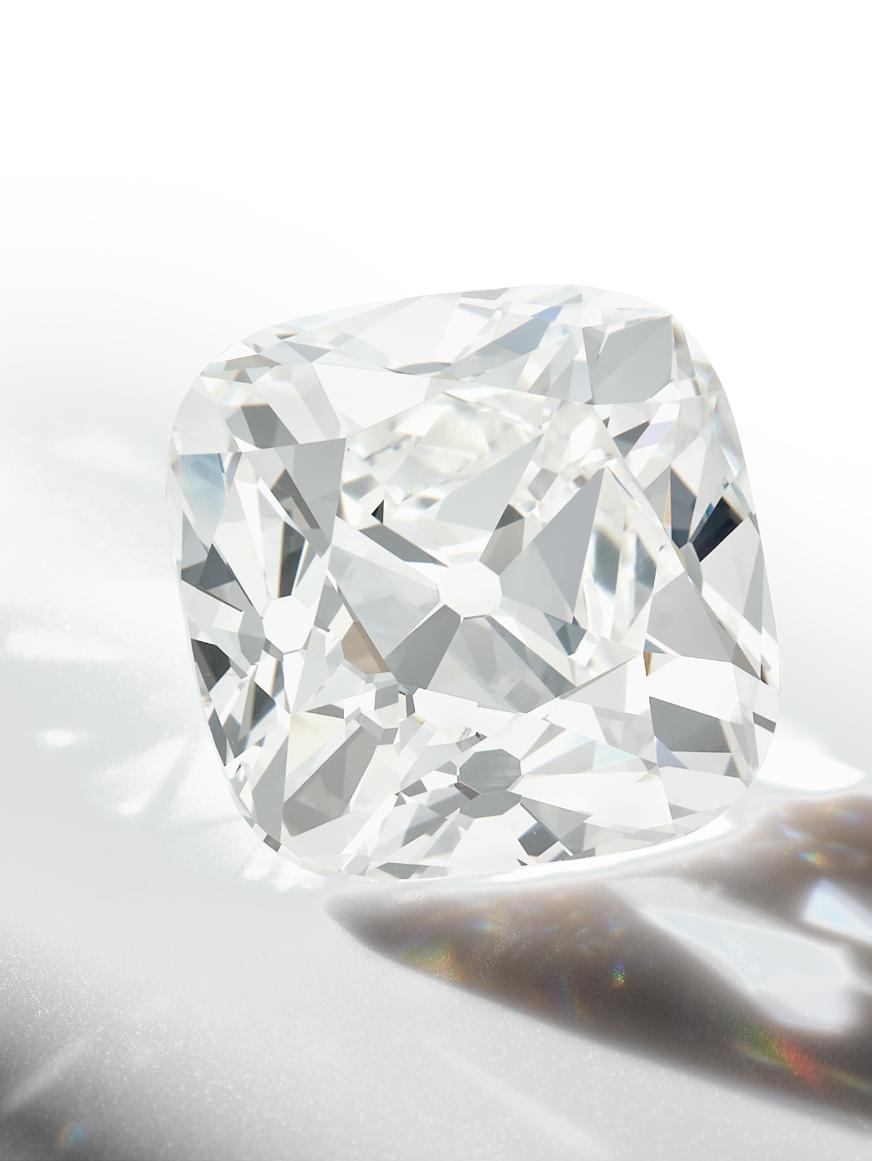
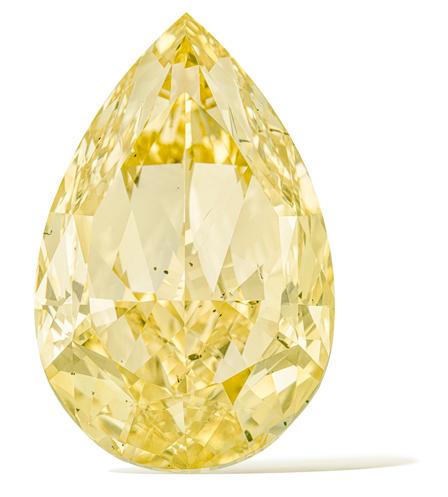
CHRISTIE’S: BESTING ESTIMATES
A202.18-carat yellow diamond was the star of the most recent jewelry sale at Christie’s in Geneva, where it garnered $6.7 million the second-highest price the auction house had ever seen for a stone of its color and size.
The unmounted pear modified brilliant-cut, fancy-intenseyellow, SI1-clarity stone, known as the Yellow Rose, originated in South Africa and was only the third of its color over 200 carats to appear at auction. It led the May 15 Magnificent Jewels sale to a total of $54.2 million, with 97% of items on offer finding buyers, Christie’s said.
“There is nothing better as an auctioneer than a full and engaged saleroom, and to achieve such strong results…is remarkable,” said Max Fawcett, head of jewels for Christie’s in Europe. “The market for colored gemstones and signed jewelry is on fire, and I could not think of a better way to start the 2024 season.”
A 25.20-carat pink sapphire also performed well, tripling its presale estimate at $1.5 million. A ring with a cushionshaped, 11.03-carat Kashmir sapphire and diamonds brought in $1.4 million, beating its $1.3 million upper presale price, while a cushion-shaped, 5.03-carat, pigeon’s blood Burmese ruby on a ring with old-cut diamonds surpassed its $1.1 million high estimate to fetch $1.4 million.
Other popular items included a Tiffany & Co. Hedges and Rows necklace by Jean Schlumberger, which went for $1.4 million, more than three times its upper estimate. Meanwhile, a turquoise and diamond Liberté jewelry set from Van Cleef & Arpels, consisting of a necklace, earrings and a headpiece, garnered $860,101, more than double its high estimate.
PHILLIPS: RISING PHOENIX
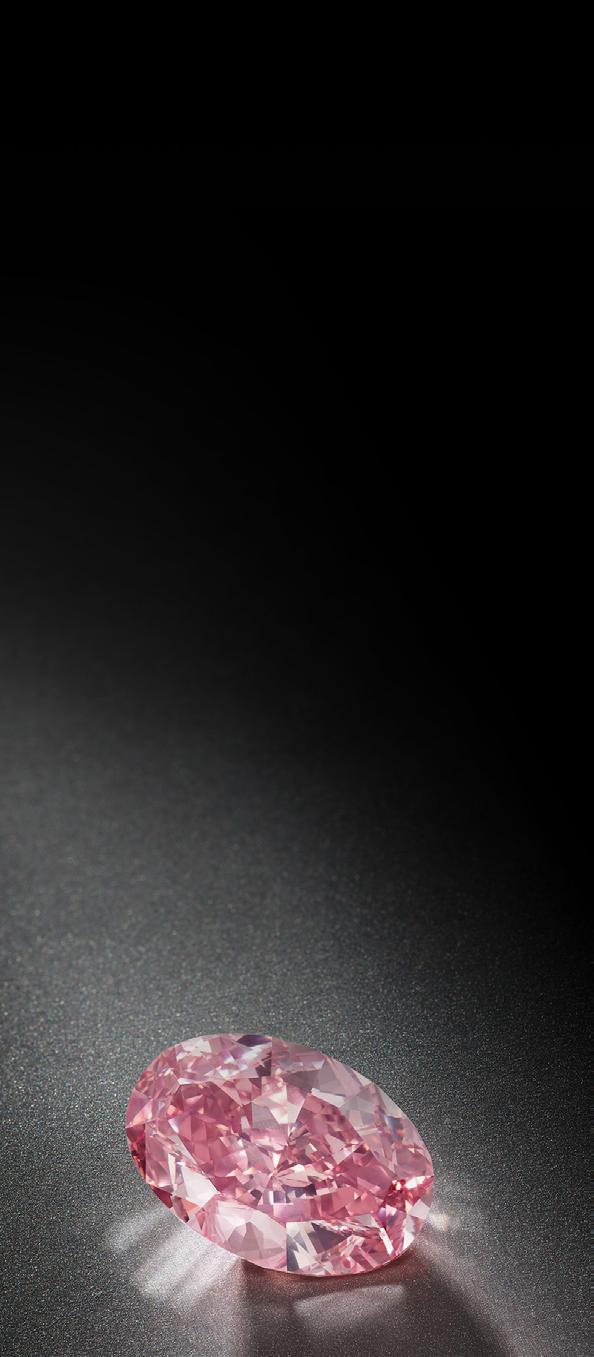
Phillips sold a pink diamond for $12 million at its second Geneva jewelry auction, which also saw two records for a fancy-red.
The ring containing the 6.21-carat, fancy-vivid-pink, VS1-clarity, type IIa diamond (pictured below) was the leading lot at the May 13 Geneva Jewels Auction: Two, Phillips said. The total, which amounted to $1.9 million per carat, fell within estimates.
Another item that did well was the Argyle Phoenix, a 1.56-carat, fancy-red diamond on a ring. The piece, which nearly tripled its high estimate to bring in $4.2 million, scored a record for both the overall and per-carat price of a fancy-red diamond at auction. The stone came from Rio Tinto’s famed Argyle mine in Australia and sold to Graff for $2.7 million per carat.
Among the other top lots were a 280.84-carat emerald pendant known as the Amazon Queen, which fetched $3.1 million beating its upper estimate and a yellowdiamond necklace by Harry Winston that nearly doubled its high estimate at $840,410. A ruby and diamond necklace went for $448,219, just under its highest predicted price. In total, the sale achieved $26.1 million, with 74% of items finding buyers.
“We are thrilled with the result…achieved today, building on the success of Phillips’s first jewels sale in Geneva last November,” said Benoit Repellin, the auction house’s worldwide head of jewelry. “The auction… showcased outstanding pieces, notably the exceptional fancy-vivid-pink diamond ring [that became] the star lot of the season across Geneva auction houses.”
The Amazon Queen “sparked a 30-minute bidding war,” he added. “We eagerly await our next jewels auction in New York, where we are excited to carry this momentum forward.”
BEHIND THE GAVEL
Meet Annabelle Cukierman, an independent jewelry expert and gemologist based in France.By Sonia Esther Soltani


How did you start your career in auctions?
At the age of 12, I went with my mother to see an auction at Drouot saleroom in Paris. I was impressed, and I fell head over heels for this profession. From that day on, my whole life changed. I began visiting museums and studying art history. I do this job out of passion, a passion for objects and the stories they tell, and the passion of the people who pass them on from generation to generation.
What was the first important piece of jewelry you handled and sold that made a lasting impression?
When I started my first jewelry auctions, several people entrusted me with exceptional pieces. I remember a rectangular Colombian emerald from the Muzo mine, step-cut, 17 carats, old mine. At that time, we didn’t work digitally, and we didn’t make videos of stones like we do now. The impression of the paper catalog was paramount. The beauty of its color could not be reproduced on glossy paper, and emeralds are always very difficult to photograph, even for a professional photographer. So I went to meet potential buyers to
show them the stone, without sending them a photo beforehand. I roamed the Place Vendôme. I was very young and unknown, but this stone opened doors for me. It’s an extraordinary memory. I understood immediately that if you have the right gem, or [a] great piece of jewelry, you can reach any potential buyer.
Who have been your mentors?
I was fortunate to meet a woman at the very beginning of my career, whom I later understood to be an exceptional jewelry antique dealer. Her name is Aviva, sister of the famous Shlomo Moussaieff. She used to have a tiny shop on Geneva’s Rue du Rhône, with the most beautiful stock of antique jewelry. She trusted me; she taught me everything. From the 19th century to Art Deco, she knew everything, and she had the most beautiful pieces on the market, signed and authentic. She taught me the levels of quality of gemstones from diamond to jade, and craftsmanship, prices, requirement for authenticity, and she introduced me to the greatest merchants of the time. I owe her a lot. During my career, which began when I was young, I had a few other mentors, mostly international diamond dealers.
Would you say jewelry auctions in France have a distinctive style, or has the market grown too global to see differences?
The French market for jewelry auctions has its own distinctions. The first is that it draws its wealth and diversity from the resources of French heritage. Many treasures ancient jewelry and gemstones are hidden in French heritage. I once appraised a case for a French family that contained exceptional jewelry dating from the 18th century to the present day three centuries of collections and transgenerational transmission! That’s exceptional.
The second distinction is that it targets all types of buyers: professionals from
all over the world or private collectors, future brides or just enthusiasts. The French auction market is very open and diverse. In the same auction, we can offer a lot for EUR 100 ($107) and another for EUR 1 million ($1.1 million)!
How would you describe your current job?
My job consists of finding treasures, evaluating them, appraising them, and describing them. Advising and informing buyers as accurately as possible. It’s a job encompassing research and transmission.
The last Kashmir sapphire I sold — a 10.43-carat stone flanked by diamonds — belonged to a French family. The owner told me, “I’ll show you a ring before I decide to throw it away, in case it’s worth something.” I took the ring in one hand and my loupe in the other and before I even thought about the kind of gems it could be, and far before I sent it to the Swiss gemological laboratories, my whole body started to shake. A Kashmir sapphire detected by shivering! Of course, we sold it for a record price: EUR 440,920 ($495,528) at the Baron Ribeyre auction house at Drouot in May 2017.
[An] Art Deco necklace [that achieved] a world record was a piece I knew for 15 years at least, belonging to a collector I advise. It was a signed Cartier piece, circa 1925, set with turquoise, coral, onyx and diamonds, which realized EUR 512,000 ($480,475) in June 2020, also at the Baron Ribeyre auction house. When she decided to sell, I was happy she contacted me instead of Christie’s or Sotheby’s. I knew I would have great collectors bidding and fighting for it. It was a great achievement.
I don’t see my job as work, but as a constant source of surprises and encounters with objects or connoisseurs. Besides, for a long time, I have been a consultant for jewelry brands in Place

Vendôme, and I have had the pleasure of building projects with people for this industry, always aiming to teach sellers about jewelry heritage and history.
Just before Covid-19, I taught at the Gemological Institute of China (GIC) at Wuhan University, which was a tremendous experience, addressing the next generation of Chinese jewelers and introducing them to Western jewelry culture, history and markets.
Is there a sale to which you are particularly looking forward?
Like every year for over 20 years, I am organizing a major auction at the Hôtel du Palais in Biarritz with Biarritz Auction

House. This French auction is close to my heart, because in 20 years, we have made it an important, anticipated and observed event by collectors and dealers from around the world.
This year, I also have a brand-new project for a summer auction on the French Riviera with the auction house Boisgirard Antonini, with which I have been working for 23 years. New projects are always exciting and a bet on the future of the market.
Which jewel would you have loved to buy for yourself?
I confess that when it comes to buying jewelry for myself, I become more of a woman than an expert. I love the jewelry my husband gives me. But it’s been a long time since I let him choose it!
A JEWELRY BOOK PAR EXCELLENCE
A new compendium of antique French jewels offers beginners and specialists alike a detailed lesson in the designs, influences and materials of key historical eras. By Phyllis
SchillerAntique jewelry conveys “incredible memories of the ages and civilizations,” as well as the stories of the women who wore the pieces, writes Dior Joaillerie creative director Victoire de Castellane in the foreword to Antique French Jewelry 1800-1950.
The book’s author is Geoffray Riondet, an antique-jewelry specialist, legal expert and gemologist. Drawing on both his own expertise and input from
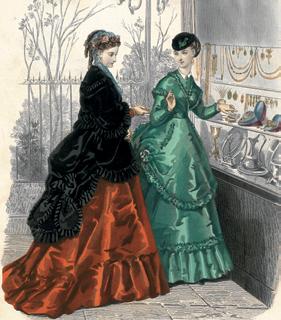
experts at the French National Institute of Gemology (ING) Paris-Lyons, he has organized what he describes as a “comprehensive overview of antique French jewelry.”
Pieces from before the 18th century rarely appear in the marketplace, he acknowledges, and the French Revolution (1789 to 1799) was a turning point. As such, Riondet concentrates on the 19th century and the first half of the 20th. Besides discussing the whys and wherefores of significant creations from the late 1700s through the 1950s, the text is illuminated with photographs, drawings and archival documents.
Putting styles in context
The century and a half that the book covers was a period when “a succession


of highly diverse styles combined traditional craftsmanship and a constant quest for innovation,” writes Riondet. These pieces often feature lost skills and serve as inspirations for today’s jewelry designers, he adds.
The book explores the notable eras within the titular time span, relating historical information as well as the fashions of the day, the popular designers, and the different ways people wore the jewelry. The reader will learn the context, inspirations and trends of the Consulate and First Empire period (1799 to 1814); the Restoration (1814 to 1830); the July Monarchy (1830 to 1848); the Second Empire (1852 to 1870); the Belle Époque (1895 to 1914), Art Nouveau (1895 to 1910) and Art Deco (1920 to 1935) periods; and the 1940s and ’50s. Riondet examines key political and economic factors and their impact on jewelry design, starting with the rise of the bourgeoisie and moving through the French campaign in Egypt from 1798 to 1801, the 1830 conquest of Algeria, and the pre- and postwar years. The
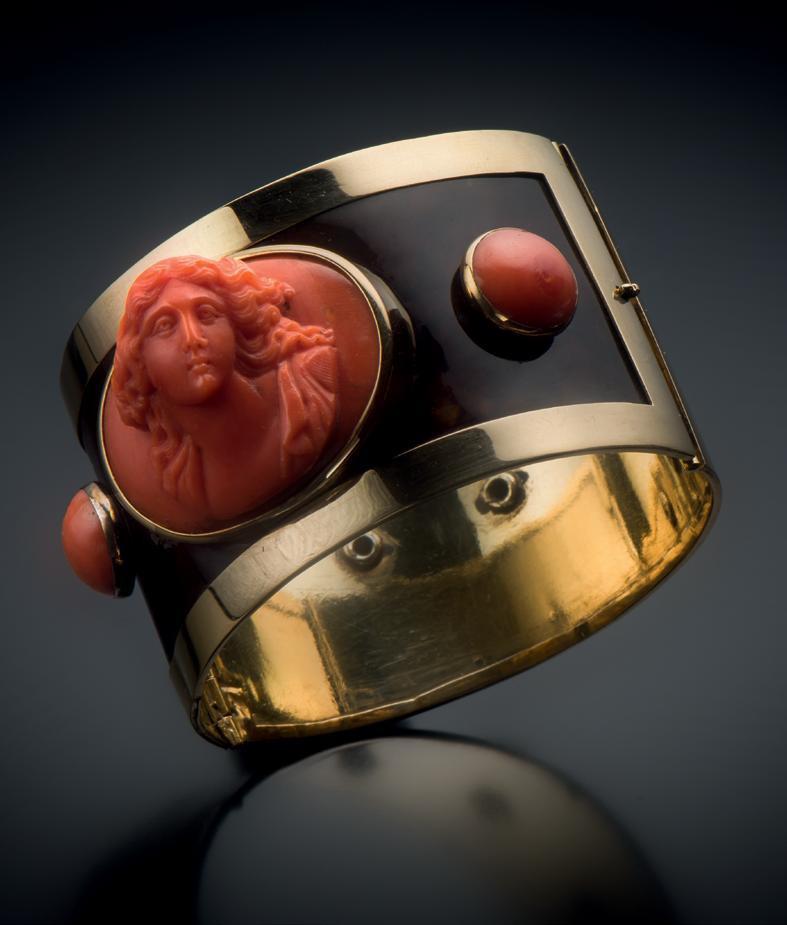

book provides context for trends like the interest in antiquities, Egyptology, neo-Renaissance and naturalistic motifs, the use of platinum, the fluidity of Art Nouveau, and the geometric forms of Art Deco. It also discusses why some design styles begin in one era and return in another or fade away completely.
Component parts
The book’s second section focuses on the materials that shaped these jewels, including precious metals — gold, platinum and silver — nonprecious ones like copper, iron and aluminum, alloys like brass and nickel silver, and natural materials like hair, wood and enamel. Along with info about the metals’ characteristics, the author lays out aspects such as the history of their use,
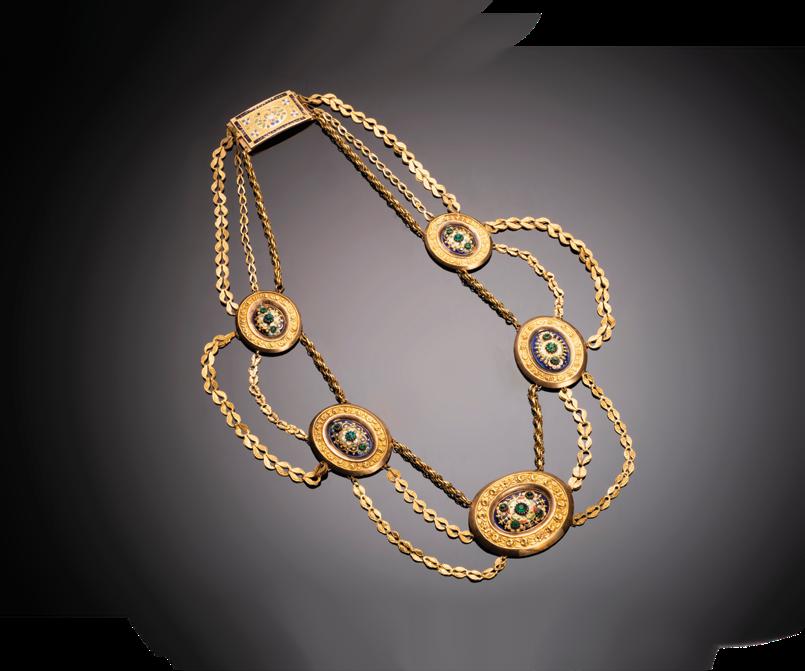
natural materials that French creators used in jewelry, such as tortoiseshell and ivory. Another section runs through the main types of jewelry categories, from rings and bracelets to brooches and head ornaments. Rounding out the book are a
list of design houses and notable artists whose influence characterized the covered time span, and a section with practical advice on getting appraisals and valuations, buying, selling, and insurance.
The final grace note to this helpful guide is a bibliography of sources to further the reader’s education about antique jewelry.
Antique French Jewelry 1800-1950 was published in April by Flammarion.

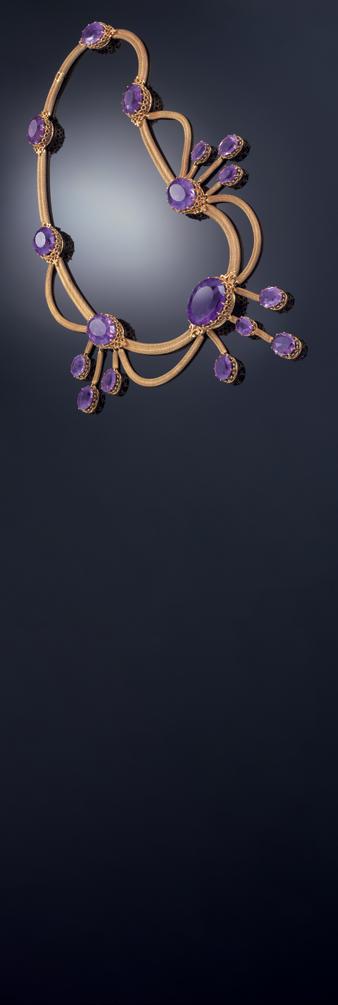
IN FOCUS: AMETHYST
ntique French Jewelry 1800-1950 offers readers a close-up look at the gemstones that featured most often in pieces from that period, including agate and aquamarine, coral and rock crystal, diamond and emerald, ivory, pearl, ruby and sapphire. For each stone, the book lists characteristics, history, color and provenance.
The gold necklace above, which dates from circa 1830, is a superb illustration of amethyst. A variety of quartz, the purple stone gets its name from an ancient Greek word that literally translates to “not intoxicated.” In antiquity, people believed amethyst could prevent drunkenness “because its color is similar to that of wine,” the book explains. The gem appears in the Bible and in the work of ancient Egyptians, and bishops in the Middle Ages wore rings with amethyst stones. During the Restoration period in France from 1814 to 1830, renewed trade with Brazil contributed to the stone’s commercialization around the world.





UNBROKEN RECORDS
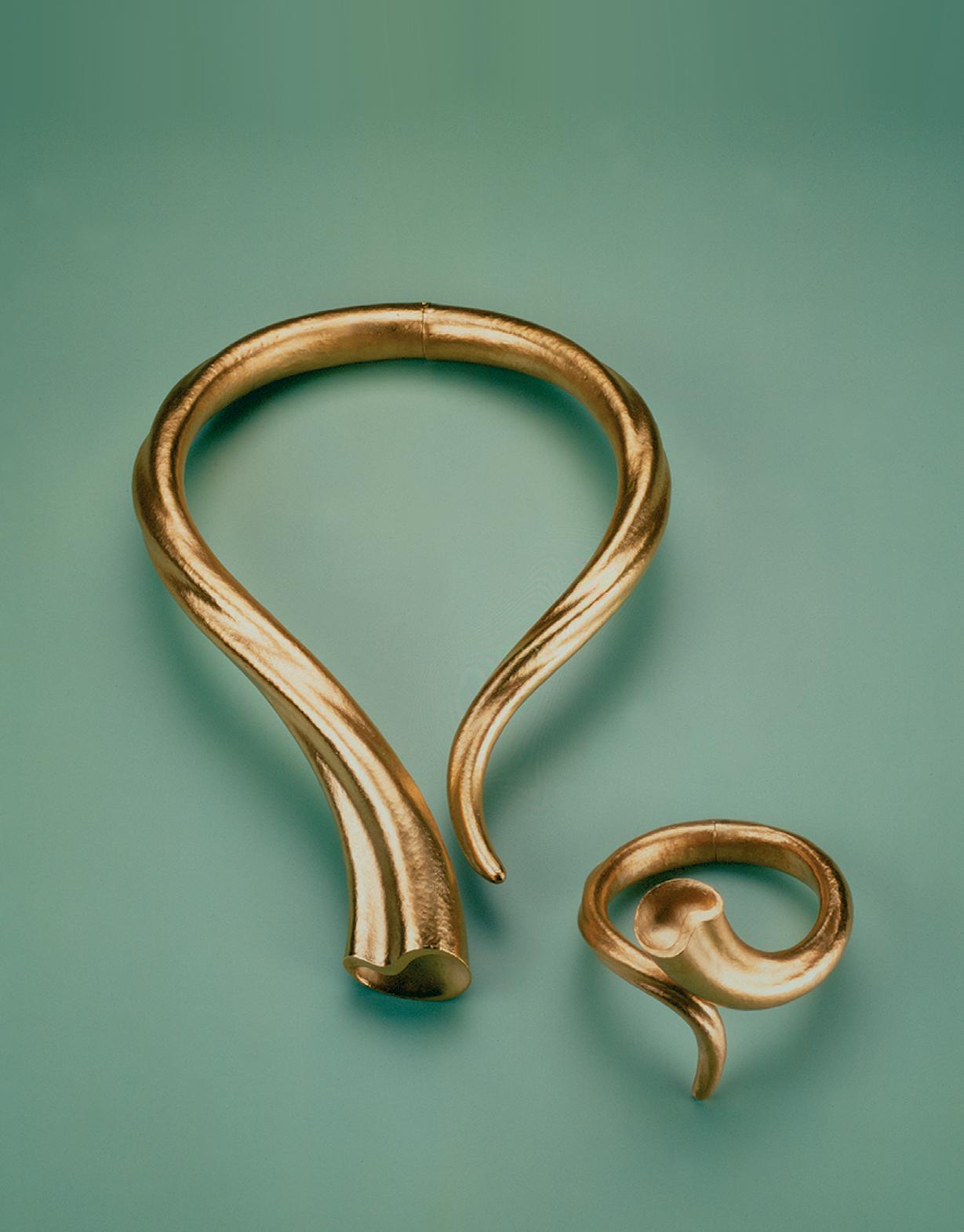
A jeweler’s archive does more than just document past designs; it helps perpetuate the brand’s legacy.
By Rachael Taylor“Astrong archive is the nexus of the entire brand DNA,” states Levi Higgs, head of archives and brand heritage at David Webb. “It’s where one should constantly be referring to, as a north star, to remain true to the visual vocabulary of a brand.”
This is especially true, he says, for a brand like David Webb, which no longer has its founder at the helm. The celebrated New York jeweler passed away in 1975, but his work lives on, supported by an extensive archive of more than 40,000 renderings and sketches, as well as editorials, photos, look books, jewels, objets and client correspondence. Higgs is in charge of protecting and building on this legacy. He does it not just to preserve the past, but also to help shape David Webb’s future: Besides helping authenticate designs, his work inspires new ones.
“The archives help us look at schematics of jewels and know exactly how to make something from the original design,” he explains. “I’m constantly showing jewelers in our workshop

“[A good archive] makes it easy for writers, historians, appraisers, dealers and auction houses to [obtain] information about pieces they find, and credit the company”

original renderings of pieces from the ’60s so they can better understand their work as they piece something together from the original molds.”
For reference
Most people tend to associate archives with heritage brands, but these creative caches don’t appear overnight. Such vaults have to be built slowly, and while there can be many other pressing considerations for a young company starting out, keeping great records in real time can be hugely helpful for the future of a brand.
Elyse Zorn Karlin is codirector of the Association for the Study of Jewelry and Related Arts, as well as a jewelry historian, author, curator and lecturer. She believes the benefits of creating and maintaining an archive are manifold.
“[A good archive] makes it easy for writers, historians, appraisers, dealers and auction houses to [obtain] information about pieces they find,
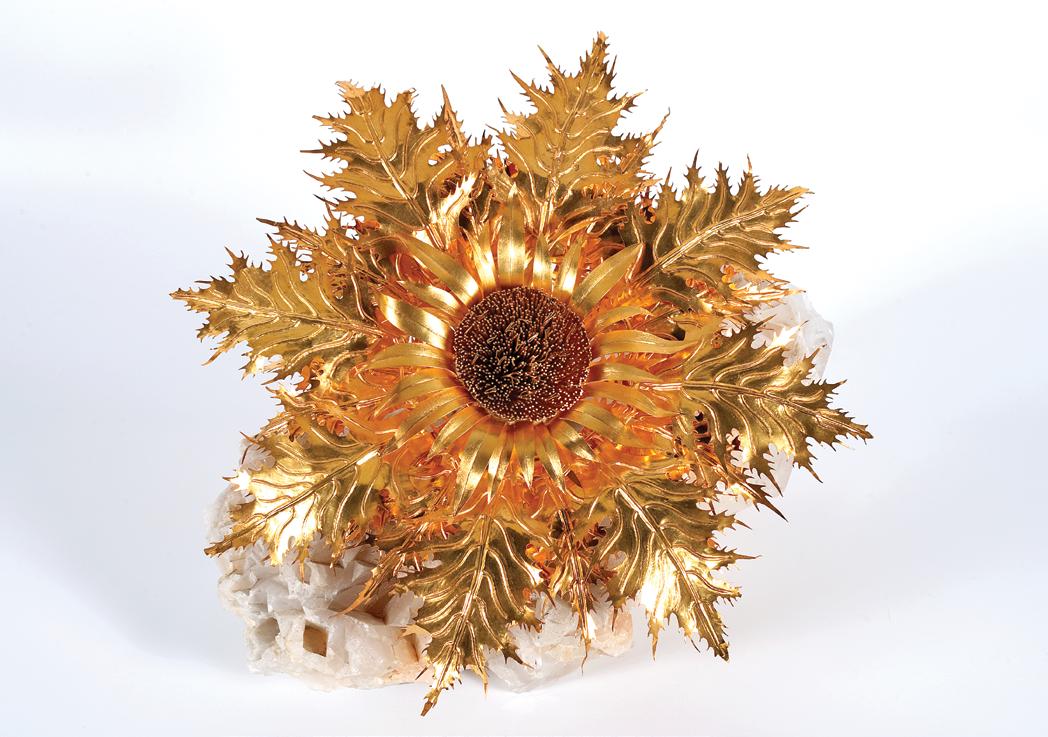
and credit the company,” says Zorn Karlin, who advises jewelers to use archiving software to keep track of photos, information and documents. Such exposure can give a brand good publicity and ensure its place in the history books, she asserts. She also believes it can add value to jewels. “Documented pieces — in books, in archives, or similar pieces in museum collections — will also be highly desirable and will probably continue to increase in value.”
A rich archive can help a brand tell its own story as well. Higgs remembers being “overjoyed” to discover a film reel in the archives from 1964 that became the basis for David Webb’s first in-house exhibition, “A Walk in the Woods,” in 2022. “We digitized it, and it became a central component through which we could explore our plethora of animal jewels.”
The art of sharing In the shadow of the Acropolis in Athens, Greece, Ioanna Lalaounis has spent the past 30 years
building a museum based on the archives of the jewelry brand her father created, Lalaounis.
“We were very lucky to receive 4,500 original artifacts that he was collecting when he was presenting his work in exhibitions around the world,” she says.
The artifacts in question are jewels that Ilias Lalaounis made throughout his career. Some are silver or gold-plated samples he created to display at exhibitions, while others are in 18- or 22-karat gold. Along with thousands of finished jewels, his daughter inherited 60,000 designs — sketches, wax models, prototypes. There is also an “enormous” PR archive, she says, and a library of hammers that were made for the Lalaounis workshop.
Being able to lean on the archives to show the evolution of the brand and its craftsmanship helps give weight to its current collections, she maintains. “You have to be able to justify why you are selling a 22-karat handmade pair of earrings for EUR 6,000 and not EUR 60. Justifying the
craft and explaining about what the history of the craft is cannot be done unless you bring out the core of how it started.”
She also believes that craft brands have a duty to share knowledge. The Lalaounis museum is open to all and offers 17 educational programs for schoolchildren, as well as research sabbaticals for jewelry designers. It also assists students; two PhDs have already been written about Lalaounis with aid from its archives.
Keeping the story alive
As for how to build a good archive, Higgs suggests that besides being impeccably organized, one should think about the why, not just the what.
“Many [designers] think to keep their sketches or ad campaigns, but then the element that is lost is the storytelling narrative — the why of a piece,” he says. “I know of a few contemporary jewelers who keep notebooks next to their workbenches and record exactly the work they did that day, details on the design process, and how a piece unfolded from thought to finished jewel. That’s imperative for someone 50 years in the future to be able to tell a really focused story of the jewel that came to be.”

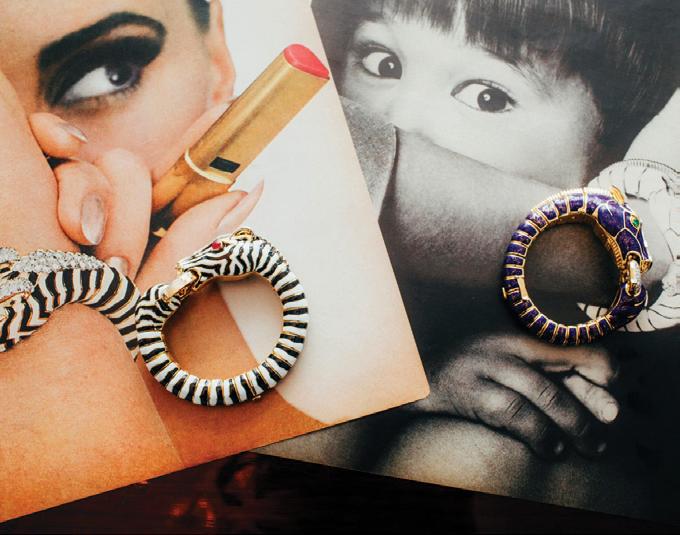

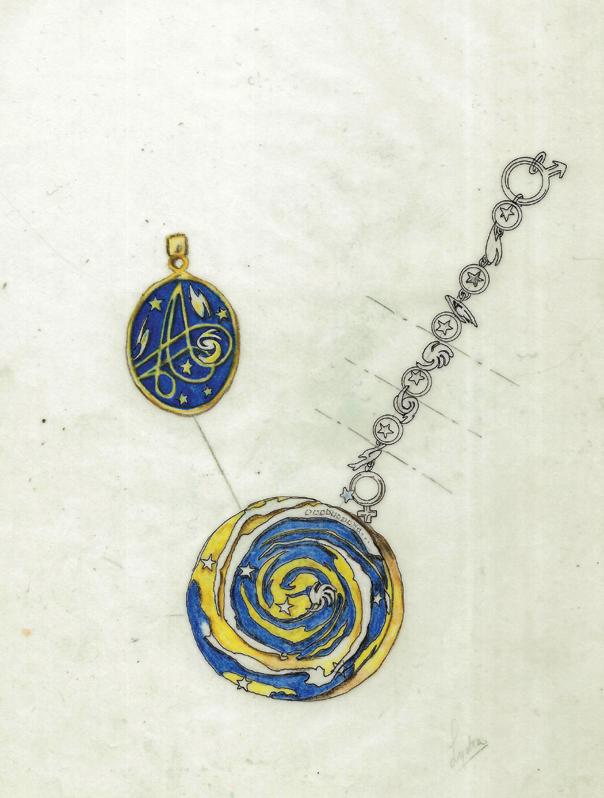



FACE PAINTING
Timepieces that transform the watch dial into a miniature canvas are drawing a new generation of collectors. By Joshua Hendren
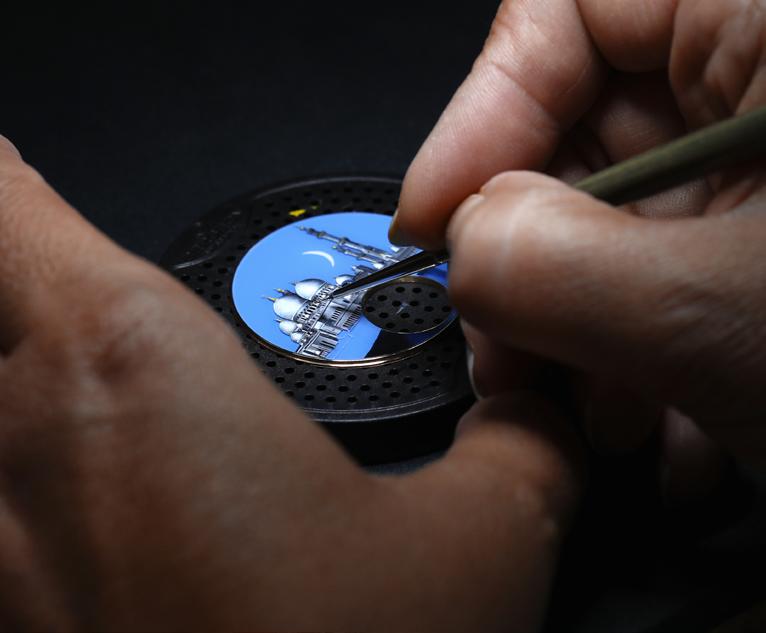
Watch dials that frame tiny paintings are highly coveted in the world of fine horology. These miniature artworks are the result of countless hours of handcraftsmanship and are increasingly fascinating a new generation of collectors.
French fashion giant Hermès, which started producing watches as far back as 1928, has long championed the art of miniature painting with its Arceau collection. Former Hermès artistic director Henri d’Origny first introduced the equestrian-inspired design in 1978, and it has since become a canvas for the house’s most technically impressive watch dials.
One of the brand’s latest models, the limitededition Arceau Wow, is one such example.

Colorful and daring, the whitegold 38-millimeter timepiece features the work of comic book artist Ugo Bienvenu across a double-sided mother-of-pearl dial. It required 35 hours of work to perfect.
Louis Moinet, an atelier of one-of-a-kind Swiss watches, has also spotlighted the craft with its new Around the World in Eight Days collection — a modern take on the classic adventure novel by French author Jules Verne. With this latest offering, the brand has created a series of eight hand-painted dials depicting famous landmarks from across the globe including the Sheikh Zayed Grand Mosque in Abu Dhabi, and the Golden Gate Bridge in San Francisco in precious materials like aventurine and rock crystal. To achieve this, Louis Moinet worked with specialist dial-maker GVA Cadrans, which created each watch face by combining fine miniature painting with engraving and marquetry techniques.
While highly prized, miniature painting in watchmaking does entail certain challenges. Not only does it require hours of meticulousness and precision, but it is subject to cracks and flaking when heated and glazed. With so few examples coming out each year, however, these miniature masterpieces will likely remain sought-after — not only for their rarity, but also for their rich storytelling and emotional value.
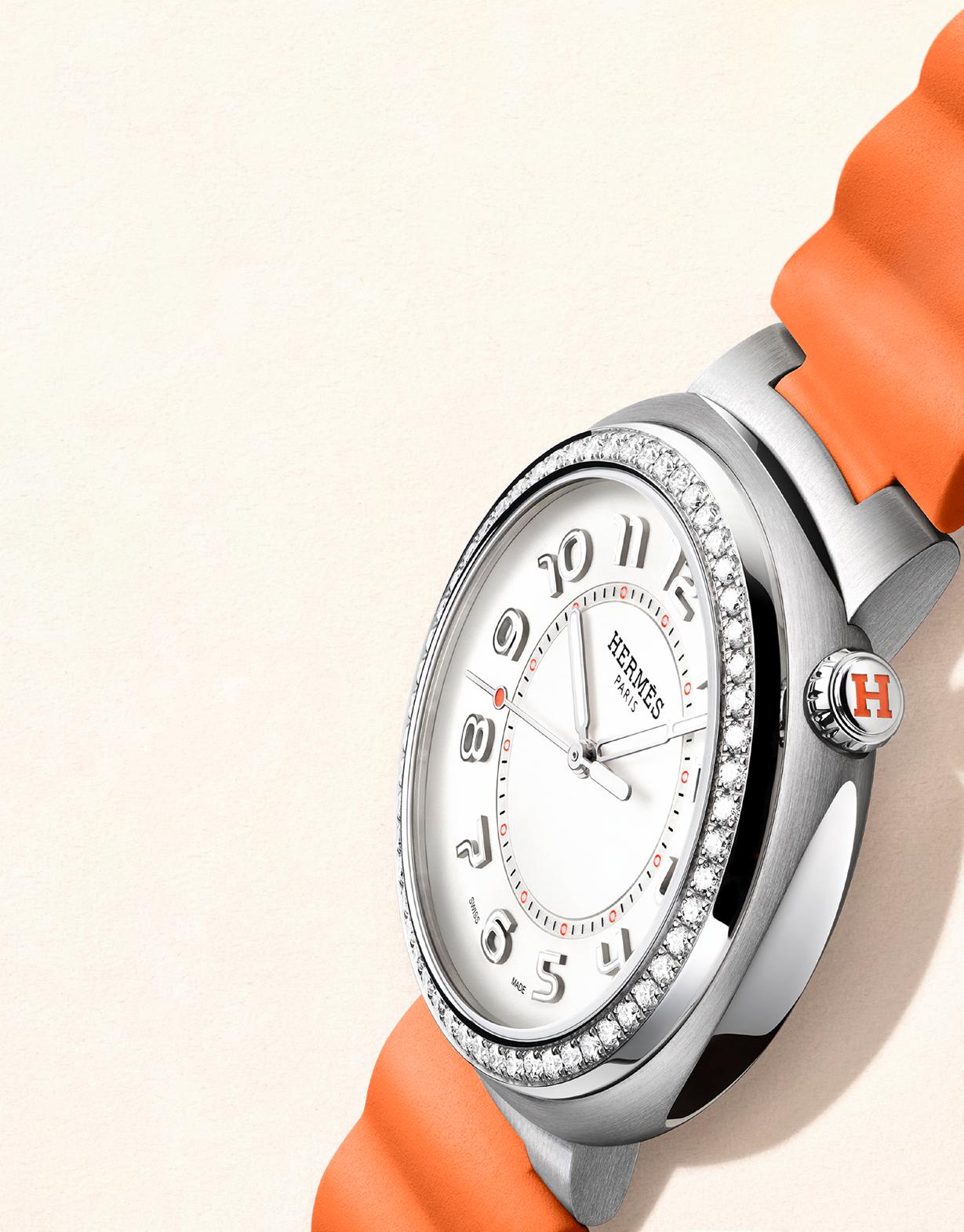
SEVEN TRENDS TO WATCH
Shrinking cases, the new moon phase, creative innovations and a surge of yellow gold — plus other key takeaways from Watches and Wonders 2024.
By Rachael TaylorCustomization
Offering clients a level of customization and choice is key, as collectors continually chase individuality. The most popular method of delivering this is through straps, and there is a drive to create straps that collectors can change by themselves without having to visit a jeweler.
Hermès’s new women’s launch, the Cut, highlighted this trend. The luxury maison gives customers the option to buy additional straps separately, which they can easily click on and off in seconds thanks to a patented system.
Piaget also offered customization on its Black Tie watches. As part of a collaboration with the Andy Warhol estate, a special line of these watches can now be made to order with dials of hard stone or other unusual materials, such as fossilized wood.
Norqain took the customization trend even further: It used the show to launch its Wild One of 1 service, which allows clients to build custom watches on its website. The buyer has a say in every element, from the movement to the style of the hands and shock absorbers, making for 3.5 million possible configurations.
Moon phase
There seemed to be a revival of moonphase complications — subdials that track the position of the moon — at this year’s show, and the best had a creative twist.
Frederique Constant introduced a motif with two crescent moons kissing, while Raymond Weil replaced the traditional moon with a human face. Laurent Ferrier presented a double moon phase to represent the moon in both hemispheres, with translucent petrol-blue enamel discs covering up the moons to indicate waning and waxing.
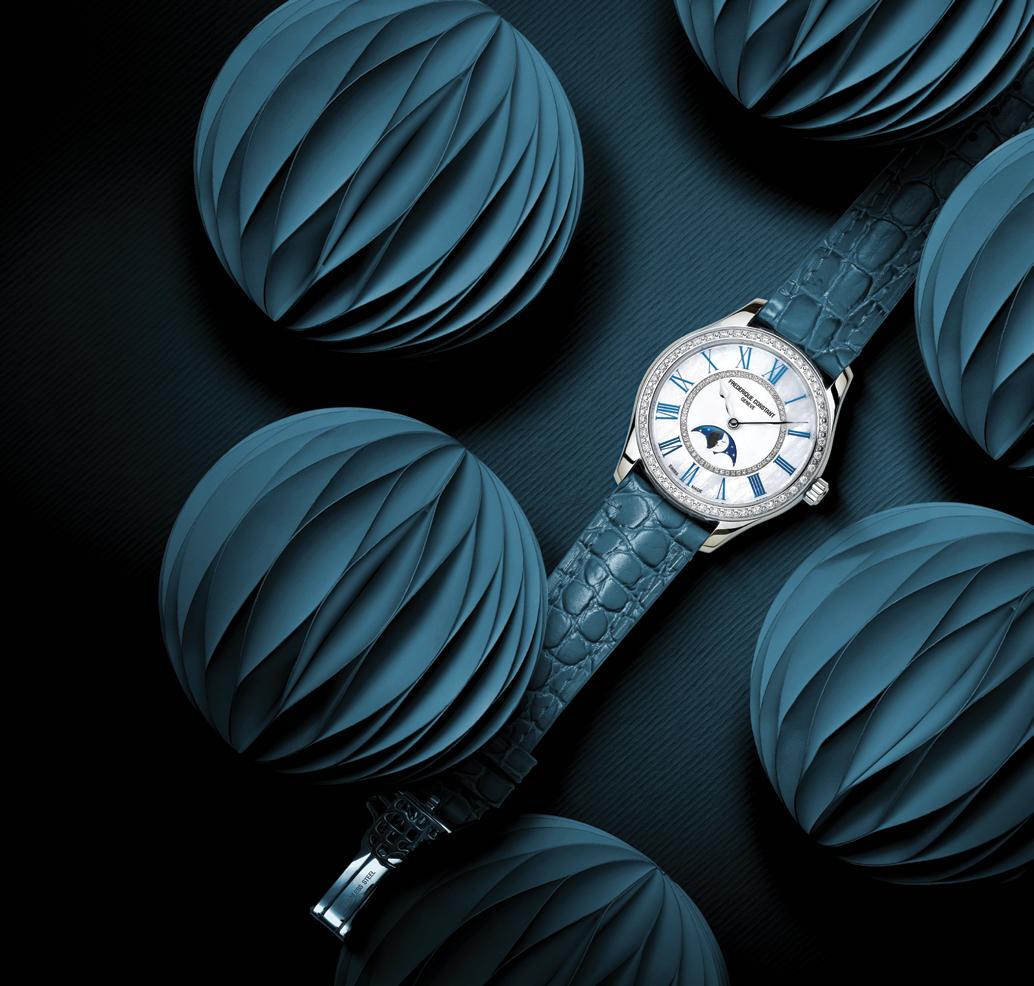

Many brands at Watches and Wonders pushed boundaries creatively as well as horologically, with launches that celebrated various métiers d’art, including marquetry, enamel work and decorative engraving.
Van Cleef & Arpels’s Lady Arpels Jour Enchanté watch was a tour de force in enamel work, creating three new patents in its wake. It featured façonné, a new style of buildable enamel used to craft three-dimensional flowers. The brand also set diamonds directly into plique-à-jour enamel.
The Hermès Arceau Chorus Stellarum featured an ondemand animation of a skeleton horse riding across the dial. The complex artwork incorporated many skills, including engraving and enamel work.
The fervor for colorful watches remained strong at Watches and Wonders, with lots of experimentation and bold choices across the dials and straps. A particularly chromatic stand was that of Nomos Glashütte, which launched a special run of Tangente 38 Date watches that offered 31 different color combinations.
In terms of trending hues, there seemed to be a revival of blue watches, with softer shades emerging such as the baby blue in the dial of a new Rolex 1908 and in the colored sapphire crystal case of Hublot’s Big Bang MP-11.
Green also remained hugely popular, and there was some excitement around Patek Philippe’s use of deep purple. Other companies produced berry hues as well.
There were some anti-color trends, too. IWC and Piaget were among the brands to showcase sand-colored dials, and there was a strong trend of black watches.
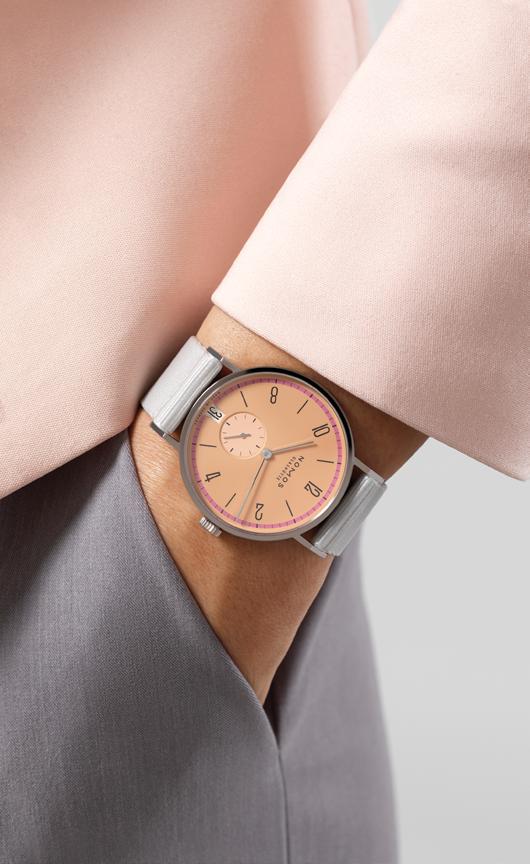

Watches as jewels
The lines separating jewelry, watches and couture blurred at this year’s show. Chanel’s collection, which took inspiration from the craft of couture and Coco Chanel’s workshop, included many timepieces that could double as necklaces. These were secret watches hidden in long pendants that took the form of dressmakers’ models, safety pins and thimbles. The brand also had a leather-and-gold design inspired by its bag straps; it is wearable as a necklace or a belt, with a simple timepiece attached as if it were a charm.
Vacheron Constantin’s transformable Grand Lady Kalla set also tapped into this theme. The wearer can transfer the diamond-set dial between a pearl tassel necklace and a diamond-set watch strap, and replace it on either piece with a diamond jewel that mimics its shape, thereby transforming that piece into a regular necklace or bracelet.
Talk at nearly every stand revolved around offering smaller case sizes. In fact, online retailer Watchfinder estimates that 36% of all watches that launched at the 2024 show were between 36 and 38 millimeters. While some brands scaled down subtly by a millimeter or two, others boldly embraced the trend with truly tiny timepieces.
Cartier adhered to the latter strategy, presenting the 24- by 16.5-millimeter Tank LC Mini and the 28- by 15.2-millimeter Tank Américaine Mini, as well as a diminutive diamond dress watch. Interestingly, Cartier did not brand the first two as women’s watches; generally, the downscaling of cases seems less about appealing to women than creating genderless collections. At the same time, men are seeking out small dress watches, thanks in part to high-profile collectors like actor Timothée Chalamet.
One of the downsides to downsizing is the movement. Making it smaller is a complicated process. As such, many women’s watches have historically run on quartz movements, though there is now investment in smaller mechanical movements. Chanel, for example, launched its Calibre 12.2 movement at the show, which can fit within a 32-millimeter case. It also announced that from this year on, it will stop fitting J12 watches with quartz movements, switching to the 12.2 instead.

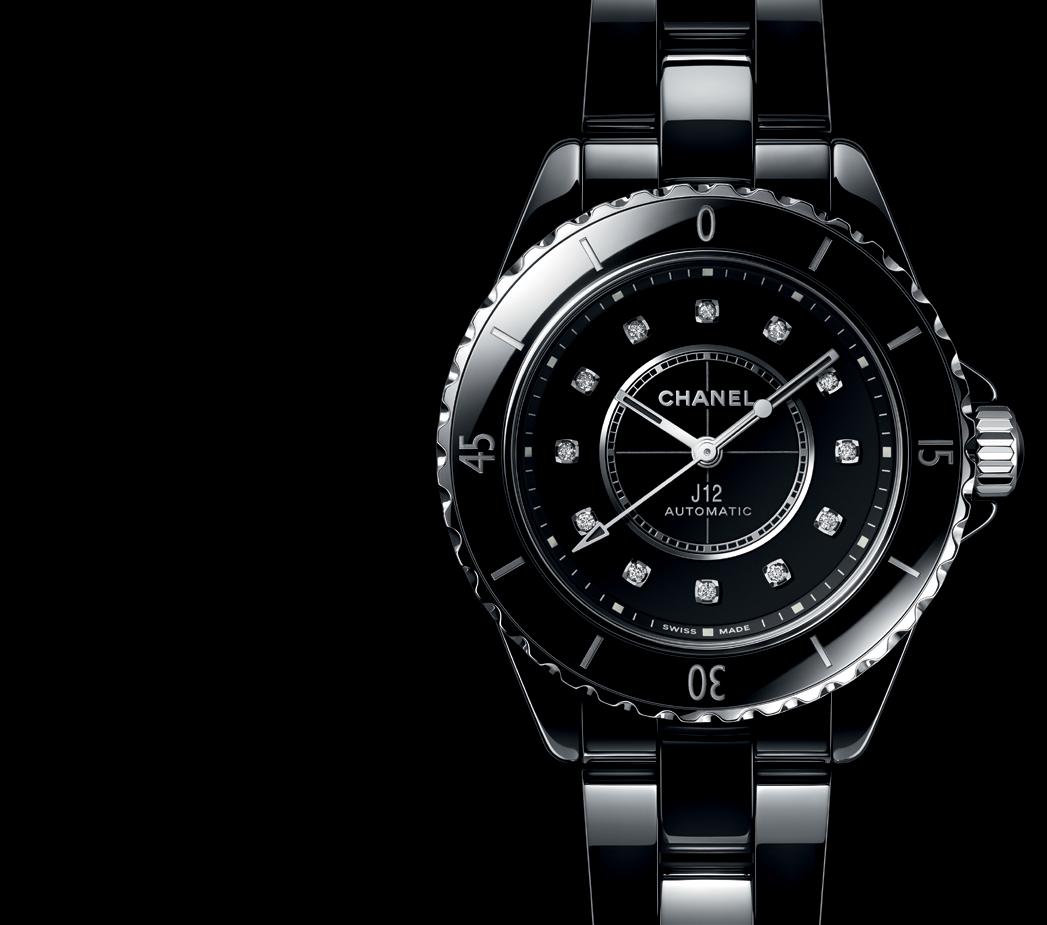
In dress watches, maisons paired yellow gold with black dials and straps, or created elaborate gold straps. Though Patek Philippe chose rose gold, it showcased the skill of its goldsmiths by creating a 1970s-inspired chain-style bracelet for its Golden Ellipse watch. The bracelet comprises 363 components with 300 hand-crafted links, and its construction achieved a new patent. Smaller case sizes
Yellow gold proved popular among new launches at the show, with brands using the metal not just for dress watches but for tool watches as well. Rolex released a solid yellow-gold Deepsea diver’s watch for the first time, while Tudor introduced its first yellow-gold Black Bay, which had a brushed finish.
Piaget leaned into the retro vibe often associated with gold watches, releasing the Polo 79 in 18-karat gold. The design, which creates the illusion of being crafted from a single block of gold, is based on a watch from 1976, but the company has updated the alloy to produce a warmer color.
A GREEN MOVEMENT
Luxury watchmakers are finding ways to reduce their environmental impact and help future-proof the planet, from using recycled materials to supporting conservation projects. By
Joshua HendrenAs the luxury market sharpens its focus on a more sustainable future, the biggest names in watchmaking are embracing new eco-friendly practices to minimize their environmental impact. What steps are they taking, and who are the innovators leading the charge?
A PERPETUAL CHAMPION
Of the high-end watch brands making major strides in implementing greener codes, few have championed these values as long as Swiss titan Rolex. Sustainability was a core tenet of the Rolex ethos well before many other companies joined the cause, but now the Swiss watchmaker is taking more proactive steps toward sustainable development.
The brand’s signature Perpetual Oyster case — the world’s first waterproof wristwatch case, which Rolex created in 1926 — is designed to last generations, minimizing waste, notes Daniel Yi, chief marketing officer at Bob’s Watches in Newport Beach, California.
“[Rolex] also uses 100% renewable energy in its production facilities and has invested in reforestation and marine conservation programs,” he adds, referring to nonprofit initiatives like Mission Blue, led by oceanographer Sylvia Earle.

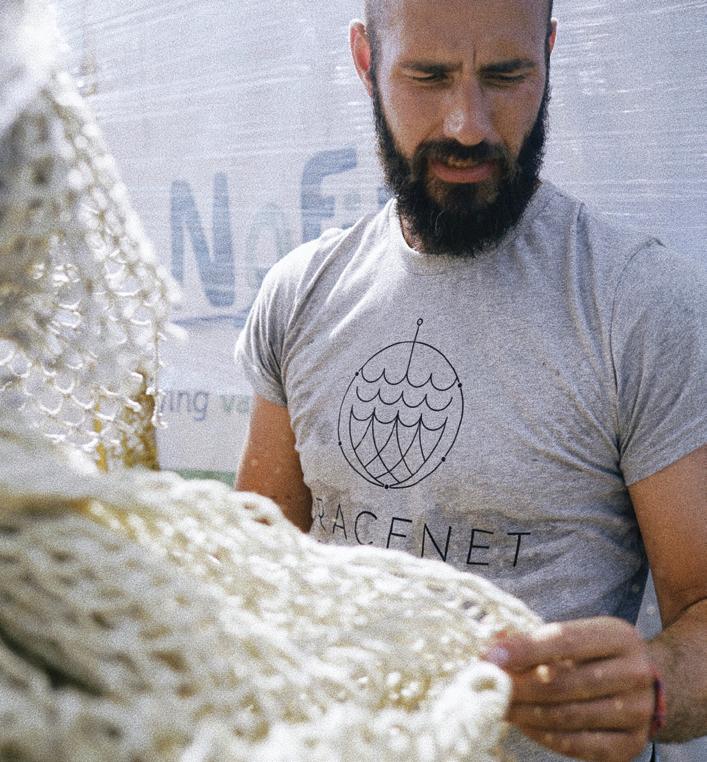
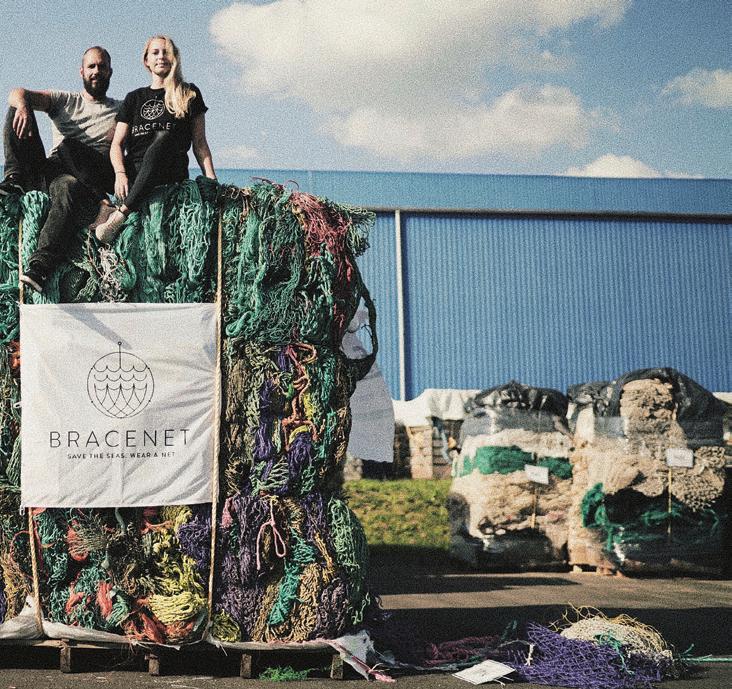
SUSTAINABLE STRATEGIES
Swiss watch brand Oris, meanwhile, has partnered with various environmental groups and clean-up movements across the world. These include the Common Wadden Sea Secretariat, which works to conserve and protect the Wadden Sea, and the UN Industrial Development Organization. The 120-year-old watchmaker has even released several limited-edition timepieces in support of sustainable causes. In 2023, it partnered with social enterprise Bracenet on a special version of its Aquis Date model, complete with a dial made from melted fishing nets.
“Relative to our profile, Oris’s environmental impact is small: Watches are low-volume products and use low quantities of raw materials,” said Rolf Studer, the brand’s co-CEO, in a 2023 sustainability report. “For example, we used 9 tonnes of steel in 2022, with the equivalent environmental impact of three return businessclass flights from Europe to Los Angeles. But that’s not to diminish our part: We all have a responsibility to bring ‘Change for the Better’” a nod to Oris’s signature tagline.
Panerai, too, has implemented sustainable strategies in its manufacturing, specifically with its eLAB-ID model, which features a case, sandwich dial and bridges consisting entirely of recycled-based materials.



A LASTING LEGACY
How can vendors advise watch collectors about sustainable options? Yi recommends sharing specific sustainability initiatives from brands so clients can make informed decisions. Furthermore, he says, “educate customers on brands that prioritize traceability in their materials. For instance, using recycled steel or ethically sourced precious metals can significantly reduce environmental impact.” Also, “promote the longevity of watches by focusing on brands that offer extensive servicing options. A well-maintained watch can last for decades, reducing the need for frequent replacements and thus lowering environmental impact.”

PLANET OMEGA
Luxury watch brand Omega is on a mission to map space debris. The Swiss watchmaker has partnered with Privateer, a data engine that maps out satellites and debris in Earth’s orbit, to promote a safer and sustainable future in space. It hopes that mapping these objects with greater accuracy and transparency will minimize potential threats to satellites that provide critical services like communication, positioning and climate monitoring.
Headquartered in Maui, Hawaii, Privateer was founded by Apple cofounder Steve Wozniak and Ripcord cofounder Alex Fielding. They head the mission along with astrodynamicist and space environmentalist Dr. Moriba Jah. Omega’s own space history stretches back more than half a century to 1962, when astronaut Wally Schirra orbited the earth six times with an Omega Speedmaster strapped to his wrist. Uniting Omega’s rich legacy of space exploration and Privateer’s innovation, the partnership raises awareness of not only our planet’s fragility, but also the impact of humanity’s footprint beyond the sea and skies.
Yi encourages participation in the pre-owned market as well. “By purchasing a pre-owned watch, collectors help extend the life cycle of luxury goods, decreasing the demand for new production and its associated environmental costs.”
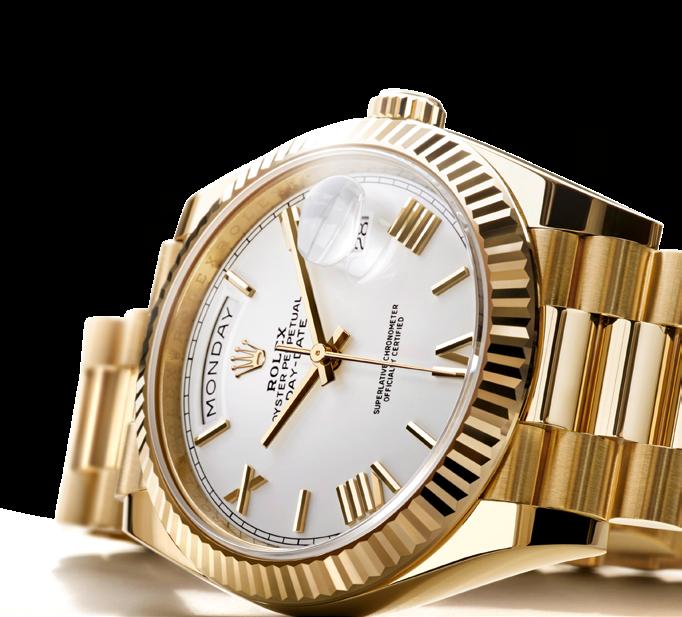

Steve Wozniak.


























































DIRECTORY
DIAMONDS
2-3 B.H.C. DIAMONDS (USA)
B.H.C. Diamonds specializes in top makes and consistent assortments ranging from 0.003 carats to 35-pointers in D to K colors, from flawless to promotional qualities.
Telephone: +1 212 997 9195 bhcdiamonds.com
7 PADMAVATI EXPORTS
Padmavati Exports has built its reputation on making diamonds more accessible, transactions more convenient, and the experience as fulfilling as possible.
Telephone: +1 212 869 0544 padmavatiexports.com
8 STULLER
Stuller is a manufacturer and distributor of jewelry and jewelry-related items worldwide. Its core product categories are bridal, mountings, jewelry, diamonds, gemstones, findings, metals, tools, supplies and digital solutions.
Telephone: +1 337 262 7700 stuller.com
BELLYBAND, BACK COVER RDI DIAMONDS
RDI Diamonds is a leading supplier of loose diamonds and has one of the largest inventories in the world. It is also one of the largest memo houses in the US.
Telephone: +1 585 225 3390 rdidiamonds.com
JEWELRY & AUCTIONS
59 RAPAPORT AUCTIONS
Rapaport Auctions is the leading reseller of diamonds worldwide. Rapaport provides a unique and reliable platform where industry businesses can sell their diamonds and receive the most competitive cash market prices. rapaportauctions.com
SERVICES
39, INSIDE BACK COVER RAPNET
RapNet is the world’s largest and most trusted diamond and jewelry trading network, delivering the best available diamonds, fine jewelry, prices, and market intelligence for diamond-industry professionals worldwide. rapnet.com
TRADE ORGANIZATIONS, PUBLICATIONS & SHOWS
INSIDE FRONT COVER
GEMOLOGICAL INSTITUTE OF AMERICA (GIA)
Established in 1931, the GIA — a public-benefit nonprofit institute — is the leading source of knowledge, standards and education in gems and jewelry.
Telephone: +1 760 603 4000 gia.edu
16 JCK
JCK Las Vegas is the leading jewelry event in North America. It features the latest domestic and international designers and most sought-after trends, showcased in a secure environment.
Telephone: +1 203 840 5958 lasvegas.jckonline.com
19, 50-51 THE AMERICAN GEM TRADE ASSOCIATION (AGTA)
AGTA is recognized within the jewelry trade as the authoritative source on natural colored gemstones — “the voice of the natural coloredgemstone, pearl and cultured-pearl industries.”
Telephone: +1 800 972 1162 agta.org
64 THE ART OF JEWELLERY
The Art of Jewellery is India’s number-one business magazine on the jewelry trade and industry. It is a one-stop source for cuttingedge information.
Telephone: +91 80 2520 1687 artofjewellery.com

73 JEWELRY CONNOISSEUR
Jewelry Connoisseur, an online publication brought to you by Rapaport’s jewelry experts, covers the latest trends in fine and high jewelry and offers practical guidance to the gem and jewelry industry. jewelryconnoisseur.net
JUNE
7-9 INTERNATIONAL
CALENDAR
GEM & JEWELRY SHOW Columbus, OH, intergem.com
8-11 INTERNATIONAL JEWELRY + WATCH VIETNAM (IJV)
Ho Chi Minh City, Vietnam jewelrytradefair.com
14-16 INTERNATIONAL
GEM & JEWELRY SHOW
Timonium, MD, intergem.com
21-23 INTERNATIONAL
GEM & JEWELRY SHOW
Houston, TX, intergem.com
28-30 INTERNATIONAL
GEM & JEWELRY SHOW Dallas, TX, intergem.com
JULY
1-2 INTERNATIONAL WATCH & JEWELRY GUILD Miami, FL, iwjg.com
5-7 INTERNATIONAL
GEM & JEWELRY SHOW
Marlborough, MA, intergem.com
11-14 SINGAPORE INTERNATIONAL JEWELRY EXPO Singapore, sije.com.sg
12-14 INTERNATIONAL
GEM & JEWELRY SHOW San Mateo, CA, intergem.com

13-16 INDEPENDENT JEWELERS ASSOCIATION (IJA) CHICAGO CONFERENCE Chicago, IL, ijo.com
19-21 INTERNATIONAL GEM & JEWELRY SHOW Pasadena, CA, intergem.com
22-25 PAWN EXPO
Las Vegas, NV pawnexpo.com
AUGUST
3-5 RJO BUYING SHOW St. Louis, MO, rjomembers.com
5-6 INTERNATIONAL WATCH & JEWELRY GUILD (IWJG) Las Vegas, NV, iwjg.com
7-9 MELEE THE SHOW New York, NY meleetheshow.com
11-12 SJO JEWELER’S SUMMIT & AI CONFERENCE Charlotte, NC, sjorg.com
11-12 THE INSTORE SHOW Rosemont, IL theinstoreshow.com
17-19 INTERNATIONAL JEWELLERY FAIR
Darling Harbour, Australia jewelleryfair.com.au
24-26 ATLANTA JEWELRY SHOW Atlanta, GA atlantajewelryshow.com
28-30 JAPAN JEWELLERY FAIR
Tokyo, Japan japanjewelleryfair.com
29-31 INTERNATIONAL AMBER AND JEWELLERY FAIR (AMBERIF) Gdansk, Poland, amberif.pl
SEPTEMBER
1-2 THE JEWELLERY SHOW London, United Kingdom thejewelleryshow.co.uk
3-7 HONG KONG WATCH & CLOCK FAIR Hong Kong, hktdc.com
7-9 MIDORA LEIPZIG Leipzig, Germany, midora.de
8-9 SELECT JEWELRY SHOW Dallas, TX selectjewelryshow.com
8-10 BIJORHCA Paris, France, whosnext.com
9-10 INTERNATIONAL WATCH & JEWELRY GUILD (IWJG) Miami, FL, iwjg.com
9-13 BANGKOK GEMS & JEWELRY FAIR Bangkok, Thailand, bkkgems.com
12-15 MADRIDJOYA Madrid, Spain, ifema.es
15-16 SELECT JEWELRY SHOW Mohegan Sun, CT selectjewelryshow.com
15-17 IDMA ANNUAL CONFERENCE Philadelphia, PA events.bizzabo.com
16-22 JEWELLERY & GEM WORLD Hong Kong gw.exhibitions.jewellerynet.com
25-29 JUNWEX MOSCOW Moscow, Russia junwex-msk.ru
26-29 PORTOJOIA
Matosinhos, Portugal portojoia.exponor.pt
28-30 COUTURE INDIA Delhi, India, coutureindia.show
28-30 MELEE THE SHOW Paris, France meleetheshow.com
28-30 PREMIERE CLASSE Paris, France, whosnext.com
29-30 SELECT JEWELRY SHOW Washington, DC selectjewelryshow.com
29-OCT 1 DELHI JEWELLERY & GEM FAIR Delhi, India, delhi.jewelleryfair.in
OCTOBER
2-5 ISTANBUL JEWELRY SHOW Istanbul, Turkey istanbuljewelryshow.com
6-9 JIS FALL Miami, FL, jisshow.com
7-8 INTERNATIONAL WATCH & JEWELRY GUILD Rosemont, IL, iwjg.com
23-25 INTERNATIONAL JEWELLERY TOKYO Tokyo, Japan, ijt.jp
24-27 NYC JEWELRY & WATCH SHOW New York, NY, nycjaws.com
27-29 JA NEW YORK FALL New York, NY, ja-newyork.com

AHEAD OF THE TIMES
Meet Randi Molofsky, the founder of New York- and Los Angeles-based brand-development agency For Future Reference. By
Sonia Esther SoltaniWhat was the piece that made you fall in love with jewelry?
My grandmother, Esther, had a diamond band with gold “X” motifs that is stretchy. I always loved the ingenuity of it and the bold yellow gold plus, the scale of the ring was unlike other pieces she wore. My mom has the ring now, and it still appeals to me from both an innovative and an aesthetic point of view.
What was your first job in the jewelry industry?
I graduated from college with a print-journalism degree, and my goal was to move to New York City as soon as possible and work at a fashion magazine. I interviewed for many positions — most of which had job descriptions that included sitting in a closet, organizing samples, and fetching coffee — but didn’t connect with anything until I spotted a
gig at National Jeweler magazine. The job title was “fashion editor,” which obviously appealed to me, but it encompassed so much more…. I was able to attend trade shows, meet designers, forecast trends, and even visit gemstone mines. It was the beginning of my love affair with the world of fine jewelry.
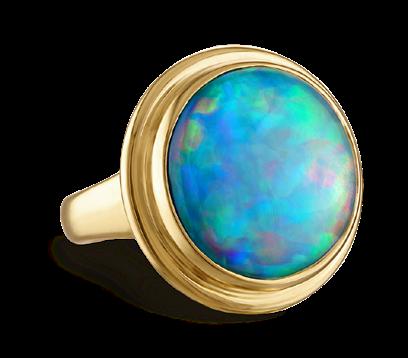
How would you describe your job in an elevator pitch? While most people call it a showroom, I think of For Future Reference (FFR) as a brand-development agency with a focus on independent fine jewelers. Instead of just selling the jewelry or just doing public relations, FFR handles both, also using strategic marketing to build brands. This way, we get to create a tailored strategy for each of our designers that brings awareness to the consumer, the retailer and the editor.
Name one of the most memorable moments in your career. Because I am so invested in my clients, my favorite moments are usually when they succeed. Watching [them] win Gem Awards [and] Couture Design Awards, or get nominated for the Council of Fashion Designers of America (CFDA) or Fashion Trust never gets old, and validates the work I do. But visiting mines in Zambia, Tanzania, South Africa and Brazil isn’t bad, either!

What are the telltale signs that you have discovered a new talent?
It’s when the jewelry and the designer perfectly intersect. Yes, the jewelry on its own needs to be great, and yes, you want the designer to be a kind person. But the times I get chills are when you see that direct connection between the work and the person, and you haven’t seen it before anywhere else in the market.
What advice would you have liked to get at the beginning of your career?
Fake it till you make it. Just because you don’t have all the answers, it doesn’t mean you can’t do the job. You have to go in there guns blazing, educate yourself, meet people, form relationships, put yourself out there. A little fear of the unknown is healthy.




